UTSA'S PATH TO GREATNESS SAN ANTONIO MUSIC HISTORY
REMARKABLE ROOKIES
SPRING 2023
MAGAZINE OF THE UNIVERSITY OF TEXAS AT SAN ANTONIO
 THE
THE

 THE
THE
In five years’ time, we’ve come a long way. When I first arrived at UTSA in 2017, there was a strong sense of hope and pride on campus that everyone felt. The university was on the cusp of achieving Tier One status, the football team and its fan base were growing, and our student success programs were gaining traction. As I look back today, I’m amazed at what we’ve accomplished together, as each one of us has contributed to UTSA’s momentum toward becoming a university of the future in the city of the future. I am so grateful to the faculty, staff and students who have given so much of themselves to make this happen.

That momentum continues today. Our Tier One research status is now opening new doors for our faculty and students. Our students are learning through real-world experiences that will give them a leg up in the workforce so that they can make their lives and the world better. And we are making great strides in addressing the inequities in our society by providing opportunities to students to lower their debt and get ahead through a quality UTSA education.
As you read this issue of Sombrilla, where we showcase the research and the researchers behind our powerful space work, I hope you’ll feel great pride as a member of our Roadrunner community. Based on these stories — and the stories of so many more of our incredible faculty, staff and students — it’s clear that UTSA is leading the way toward developing solutions to society’s grandest challenges.
You’ll also see how the creative force that has always existed in San Antonio through its music and cultural richness is being preserved and celebrated in new ways with our research in the Westside community and beyond.
I’m grateful to be a witness to this important time in our university’s history and look forward to celebrating alongside each of you as we continue to achieve more.
With appreciation,
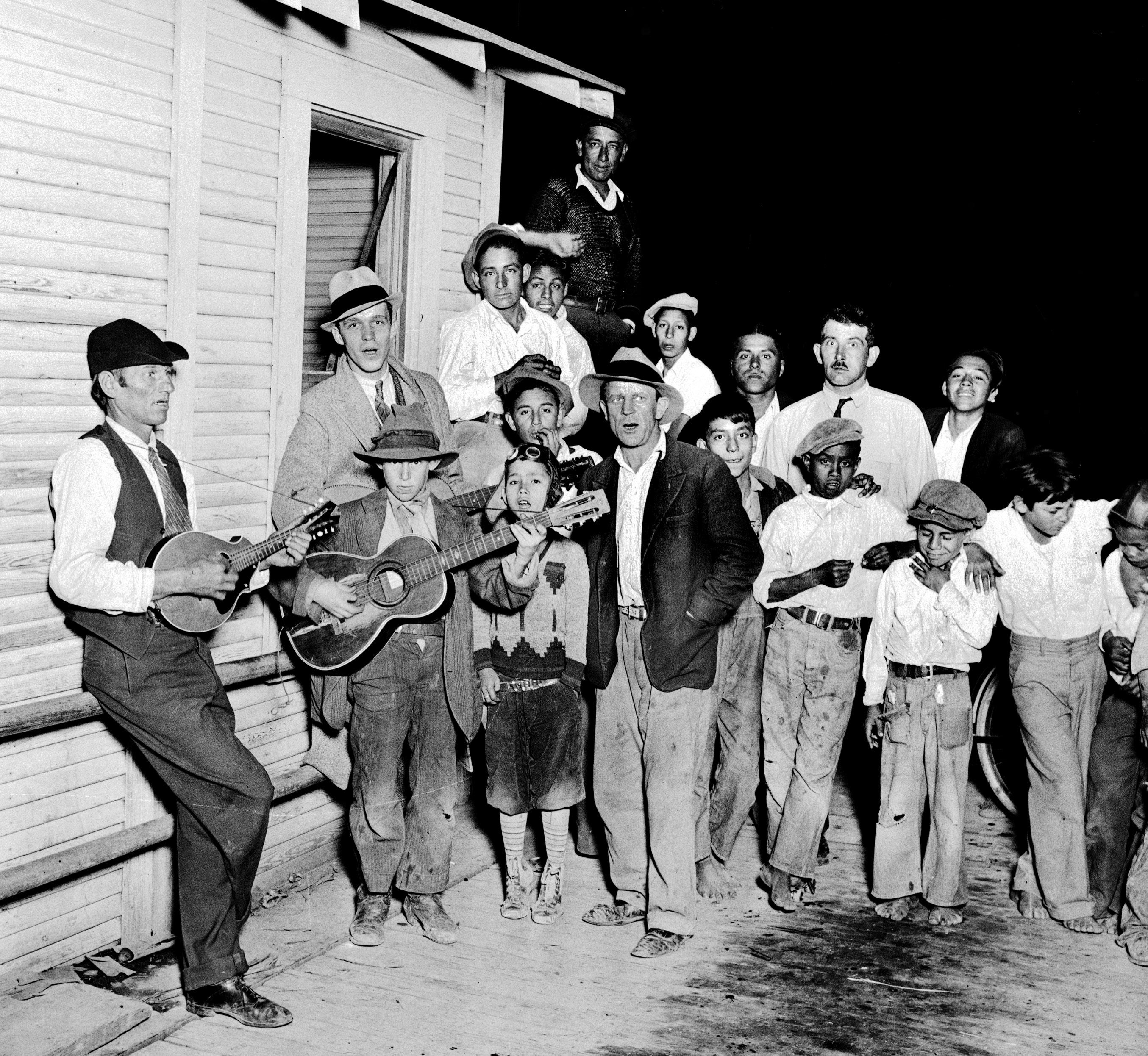
4 Plazas & Paseos
12 UTSA’s Path to Greatness
16
FEATURE
The Roadrunner’s Guide to the Galaxy
24
FEATURE La Música de la Cultura
34 ’Runners & Shakers
40 Q&A
16
THE ROADRUNNER'S GUIDE TO THE GALAXY
Learn how UTSA is playing a significant role in recent astronomical breakthroughs and is laying the groundwork for vital space-related projects in the future.

Plazas & Paseos
4 PODS OF THUNDER
Researchers at UTSA and LSU have teamed up to show how heat-absorbing materials and other urban conditions are making thunderstorms more prevalent throughout cities in the Southeastern U.S.
6 DISCOVERY
Read about five research projects at UTSA, including an exploration of the healing power of honey, algorithms leading to safer gadgets and the development of systems assisting the visually impaired.
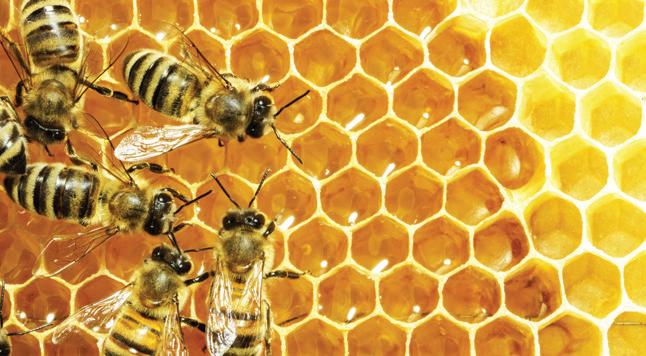
THE BILINGUAL ADVANTAGE
UTSA is partnering with the San Antonio Independent School District to create a network of schools that will advance bilingual education through teacher training and support.
8
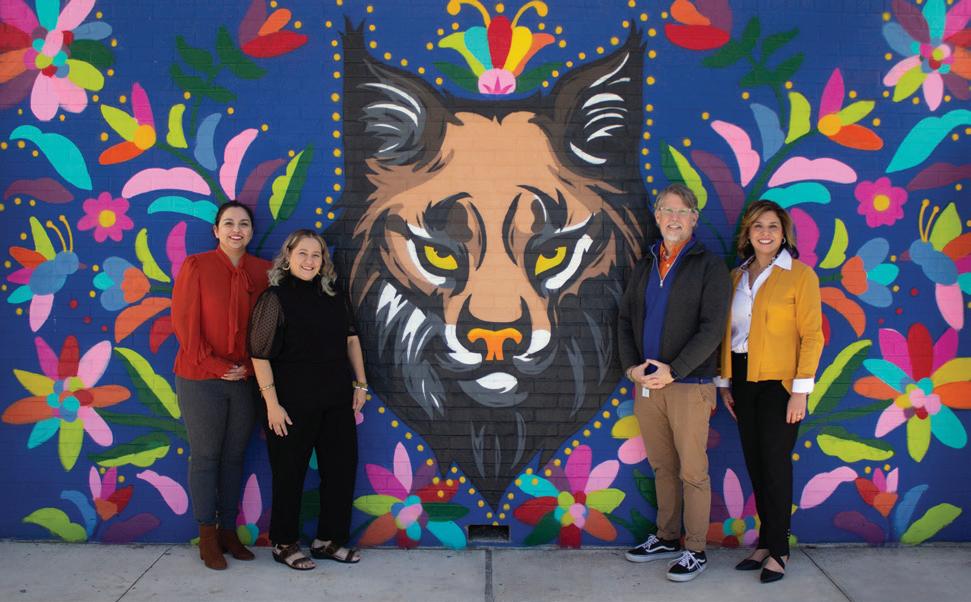
Q&A NO STAGE TOO GRAND OR TOO SMALL
Nicole Cherry discusses her personal and professional journey as a classical violinist on an international stage, bringing attention to historical, current and future representation of diverse composers and performers in the field.

Through projects, performances and teaching, UTSA is preserving the cultural roots of the San Antonio community through music that illuminates both history and today’s important issues.

TAYLOR EIGHMY PRESIDENT
TERESA NIÑO VICE PRESIDENT FOR UNIVERSITY RELATIONS
JOE IZBRAND ASSOCIATE VICE PRESIDENT FOR STRATEGIC COMMUNICATIONS AND EXTERNAL AFFAIRS
MARGARET LAMAR MANAGING EDITOR
VALERIE BUSTAMANTE JOHNSON SHEA CONNER SENIOR EDITORS
34

REMARKABLE ROOKIES
After helping UTSA win its first conference championship as seniors in 2021, Tariq Woolen and Spencer Burford shattered expectations in their first pro seasons in the NFL.
38
BREWING SOMETHING SPECIAL
Looking for a new spot to get your caffeine fix? Get to know UTSA alumni Yuli Chang and Nirav Amarnath, who each launched their own one-of-a-kind coffee and tea shops in San Antonio.
COMING FULL CIRCLE
Hafsa Ali’s captivating journey took her from Pakistan to New York City to San Antonio. Now, the UTSA M.B.A. student is heading back to the Big Apple to pursue her dream job.
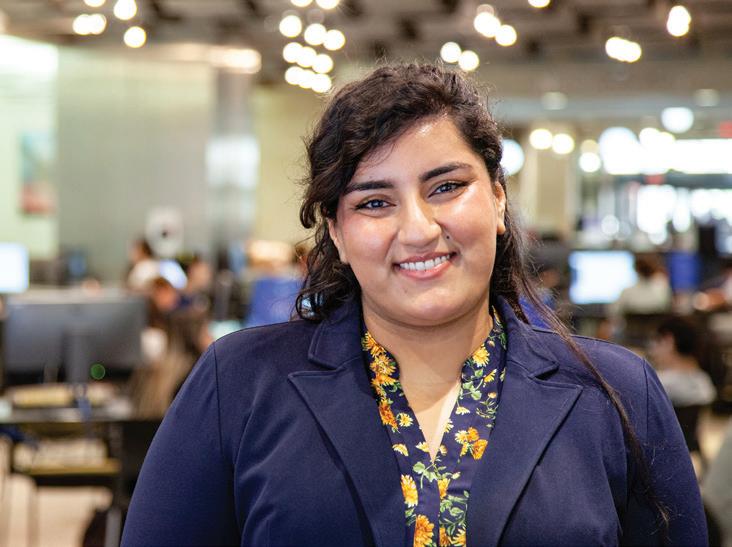
40
CHRISTI FISH TRICIA LYNN SILVA ASSOCIATE EDITORS
JORDAN ALLEN ARI CASTAÑEDA CATHERINE FLORES CONTRIBUTING WRITERS
CORAL DIAZ NOELLE ARTIGUE GRAPHIC DESIGNERS AND ILLUSTRATORS
KATIA DIAMANTE SOCIAL MEDIA EDITOR
Are you interested in sharing news with members of the UTSA community? Or would you like to change your contact details or subscribe? Please contact us:
SOMBRILLA MAGAZINE OFFICE OF UNIVERSITY STRATEGIC COMMUNICATIONS ONE UTSA CIRCLE SAN ANTONIO, TX 78249-1644
SOMBRILLA@UTSA.EDU
Sombrilla Magazine is the official publication of The University of Texas at San Antonio. It is distributed without charge to students, alumni, faculty, staff and friends of UTSA. The magazine strives to capture the intellectual, cultural and social life of the university.
sombrilla /sohm–BREE–yah/ Spanish for Umbrella S
Take a walk down a sunny city street, and you’ll notice how much hotter it feels than strolling along a country road or even a suburban cul-de-sac. But that downtown heat doesn’t just bring moisture in the form of sweat. It’s also setting the stage for more frequent rainfall and thunderstorms.
Throughout American history, urban cores have been constructed with heat-absorbing materials like concrete, steel and asphalt. Cities also generally have higher concentrations of machines that pump heat into the atmosphere and lower concentrations of cooling vegetation. This increased temperature in city cores provides a source of unstable air that creates rain clouds. This is commonly known as the urban rainfall effect
Neil Debbage, an assistant professor of geography and environmental sustainability in the UTSA College of Liberal and Fine Arts, has studied the effects of large cities on climatology for years. Recently, he and UTSA graduate geography student Jewel Uzquiano teamed up with graduate meteorology student Robert Forney and geography
professor Paul Miller of Louisiana State University (LSU) to observe how metro areas throughout the Southeastern United States enhance thunderstorm frequency. The collaboration resulted in a NASA-supported research paper that was published in Urban Climate in 2022.
One of the driving forces behind his research is urban flood resiliency. A better understanding of the urban rainfall effect will inform city leaders and first responders on how to prepare for potentially hazardous weather events.
“To fully prepare for flooding, urban planners and emergency managers likely need to account for urban amplification of precipitation,” Debbage explains. “It is, in many respects, a double whammy, where urban environments can increase the initial rainfall and then also increase runoff once the precipitation reaches the ground.”
Debbage and his team developed a methodology to create an urban convection ratio (UCR) for each city. The UCR compared the frequency of “weakly forced” thunderstorms — which are storms driven largely
by Shea ConnerUTSA researchers find urban effects are leading to more frequent thunderstorms in Southeastern cities
by atmospheric instability and moisture — to the frequency of storms anticipated as a result of geophysical factors alone. Finding these UCRs allowed the researchers to specifically isolate urban influences on thunderstorm activity.
Previous studies have mostly focused on a limited number of large cities, so the UTSALSU collaborative examined weakly forced thunderstorms over a 14-year period in 32 urban environments across the Southeastern U.S. The study included large metro areas such as Atlanta, Miami and New Orleans in addition to smaller ones, such as Hickory, N.C., Jackson, Miss. and Huntsville, Ala.
New Orleans, Memphis and Tampa emerged as the cities with the largest urban convection ratios in the Southeast, suggesting that these three urban environments dramatically enhance thunderstorm activity.
“I think this study sets the stage for future modeling work to more fully understand the specific physical mechanisms that explain the large UCRs in New Orleans, Memphis and Tampa,” he explains.
While those large cities could
prove to be informative study sites for the urban rainfall effect, so too could Knoxville (No. 5) and Norfolk (No. 9) — two relatively smaller cities that exhibited significant thunderstorm enhancements. Their inclusion in the top 10 suggests that the urban rainfall effect is widespread throughout the Southeast.
Debbage recently started preliminary work on a followup study examining how the shapes, durations and intensity of thunderstorms in urban environments differ from their rural counterparts. Moving forward, he hopes to apply the UCR approach to cities beyond the Southeast.S
OF THE 32 CITIES STUDIED BY RESEARCHERS AT UTSA AND LSU, ATLANTA HAD THE SIXTH-LARGEST URBAN CONVECTION RATIO, SUGGESTING ITS URBAN ENVIRONMENT GREATLY ENHANCES THUNDERSTORM ACTIVITY.
Of the 32 Southeastern cities included in the study, these 10 had the largest urban convection ratios:
 NEW ORLEANS TAMPA SARASOTA MIAMI
NEW ORLEANS TAMPA SARASOTA MIAMI
An apple a day keeps the doctor away, but what about a spoonful of honey? Ferhat Ozturk, assistant professor in the UTSA College of Sciences is exploring the medicinal potential of the sweet substance and what its health benefits can do for the body.
Working alongside students, Ozturk is testing varieties of honey for bacterial cultures with the goal of identifying which cultures are the best at killing and/or inhibiting the growth of the bacteria. He has collected about 60 honey samples from across Texas, 35 of which are from the San Antonio area. Honey, known for its anti-inflammatory, anti-bacterial, antioxidant and anti-aging properties, can be used as a treatment for a variety of conditions, such as
treating mouth sores that cancer patients develop when undergoing chemotherapy.
“Honey has been used as an antibacterial solution for thousands of years,” Ozturk says. “The Egyptians, Romans, Greeks and Turks used honey for wound healing. It’s been shown to kill bacteria — almost any bacteria. Our main objective is to find which honey can be

While people enjoy the convenience of their Ring doorbells to watch their front porches or play the latest Taylor Swift song on their Alexas, cybercriminals could be using them for other purposes.
Elias Bou-Harb, associate professor in the UTSA Carlos Alvarez College of Business is working to find a way to design and implement algorithms to fingerprint these exploited devices — also known as Internet of Things (IoT) devices — and discover their security problems.
“Most of today’s wars are not physical. They’re either economic or cyber wars,” Bou-Harb says.
With a $500,000 grant, researchers will analyze IoT devices and will report findings to their laboratories before analyzing network traffic to better understand their traits and security protocols.
The knowledge gained from the research will be applied directly in the classroom through virtual labs and workshops focused on primarily female and minority students.
IT CHANGED MY APPROACH TO MEDICINE. I MADE THE LINK, AND THE MORE I LEARN HOW HONEY HAS BEEN USED AS MEDICINE, THE MORE FASCINATED I BECOME.ALVAREZ COLLEGE OF BUSINESS SAFER GADGETS
used best for which disease and at the same time which honey has the most healing potential.”
Assistant Professor in the UTSA Department of Computer Science

Department of Criminology and Criminal Justice
COLLEGE OF HEALTH, COMMUNITY AND POLICY
A new UTSA project will increase access to high-paying and flexible tech careers for students with blindness and visual impairments (BVI). Researchers are developing a web interface that will help students with BVI learn computer science, artificial intelligence and data science.
The new technology will include a more advanced screen reader that will help students with computer programming. Current systems have limited screen readers for reading data, which means students cannot fully access what’s on the screen.
“The success of this project will improve the way we teach computer programming and data science to students with BVI,” says Wei Wang, assistant professor in the UTSA Department of Computer Science.
“More individuals with BVI will be able to learn how to program and find rewarding career opportunities, which will also lead to a more diverse computer science workforce.”
Soon we will understand the effects of traumatic brain injury (TBI) on people reentering the community after incarceration. The research of Chantal Fahmy and Alicia Swan, assistant professors in the UTSA College of Health, Community and Policy, focuses on how repeated TBIs affect behaviors among inmates and how those behaviors can lead an individual into a cycle of repeated crime and imprisonment.
“One piece that comes up a lot in the TBI injury space is that their injuries are preventing them from engaging in social or recreational activities, so they don’t feel like they’re part of a healthy community,” Swan says. “When you have those more fundamental, happy positive connections with your environment and your community, you’re less likely to engage in behaviors that are going to be maladaptive and lead you to substance abuse or negative behaviors.”
The researchers’ primary goal is to create data-driven solutions to improve rehabilitation efforts.


“By highlighting the importance and scope of the problem of TBI, we would help rectify cognitive deficits to better society as a whole” Fahmy says.


Jorge Felipe-Gonzalez, assistant professor in the Department of History, will join collaborators in Australia as part of an international project exploring the trans-Pacific slave trade. The project, in partnership with the University of South Wales, is key to discovering the origins of non-native populations that now live in the South Pacific as a result of forced migration.
It will showcase UTSA’s contributions to contemporary research and the need for highly specialized researchers around the world who can help individuals trace the roots of their lost family members. Additionally, it will support communities that have been impacted by the slave trade.
“I have been working for almost 10 years studying the trans-Atlantic slave trade,” Gonzalez says. “This latest project will help diversify my research at UTSA by focusing on the slave trade in the Pacific Ocean and how it relates to trade routes across the world.”S
To learn more about these DISCOVERY research projects and more, visit UTSA Today.
WEI WANG CHANTAL FAHMY Assistant Professor in the UTSA ALICIA SWAN Assistant Professor in the UTSA Department of Psychology JORGE FELIPE-GONZALEZ Assistant Professor in the UTSA Department of History COLLEGE OF SCIENCES & COLLEGE OF EDUCATION AND HUMAN DEVELOPMENT COLLEGE OF LIBERAL AND FINE ARTSIfsomeone were to poke their head into certain classrooms in the San Antonio Independent School District (SAISD), they’d notice something special. They’d see that the students aren’t just learning about history or their multiplication tables in English. Throughout the school day, these students — many as young as pre-kindergarten — are conversing fully in English and Spanish with their teachers and classmates .
These students are part of the Dual Language Community Lab Schools Partnership. With the teamwork of UTSA and SAISD, the practice of dual language education is advancing and evolving — not only locally in San Antonio but as a model for others across the nation.
For years, the UTSA College of Education and Human Development (COEHD) and SAISD had a strong relationship of community outreach with the help of UTSA Associate Dean for Professional Preparation and Partnerships Belinda Bustos Flores, and Olivia Hernandez, former SAISD assistant superintendent of bilingual education and ESL. Through this dual language partnership, there is now an opportunity to
build on that success by making strides to broaden this important educational practice.
“Dual language instruction not only leads to bilingualism and biliteracy, it builds self-confidence in students. Being able to say you speak two languages empowers students and gives children cultural, cognitive and economic advantages,” says Juanita Santos, partnership executive director.
Dual language programs also allow young students the opportunity to gain a global perspective, especially as they get into their teen years and eventually adulthood, Santos says.
“What makes this Dual Language Community Lab School truly unique is its commitment to research informing practice and the other way around,” UTSA

COEHD Dean Mario Torres says. “It’s extraordinary to think what is possible when schools and universities realize their mutual interests in academic success and refuse to get bogged down by bureaucracy and red tape. When children are at the center of these ideas, wonderful things happen.”
Four in-district elementary charter schools in SAISD — the James Bonham Academy, Irving Dual Language Academy, Mark Twain Dual Language Academy and Charles Graeber Elementary School — are serving as a network for how other school districts can evolve their dual language programs. The partnership is advancing the preparation of Pre-K through 8th grade teachers, principals, counselors and school psychologists at the four elementary schools.
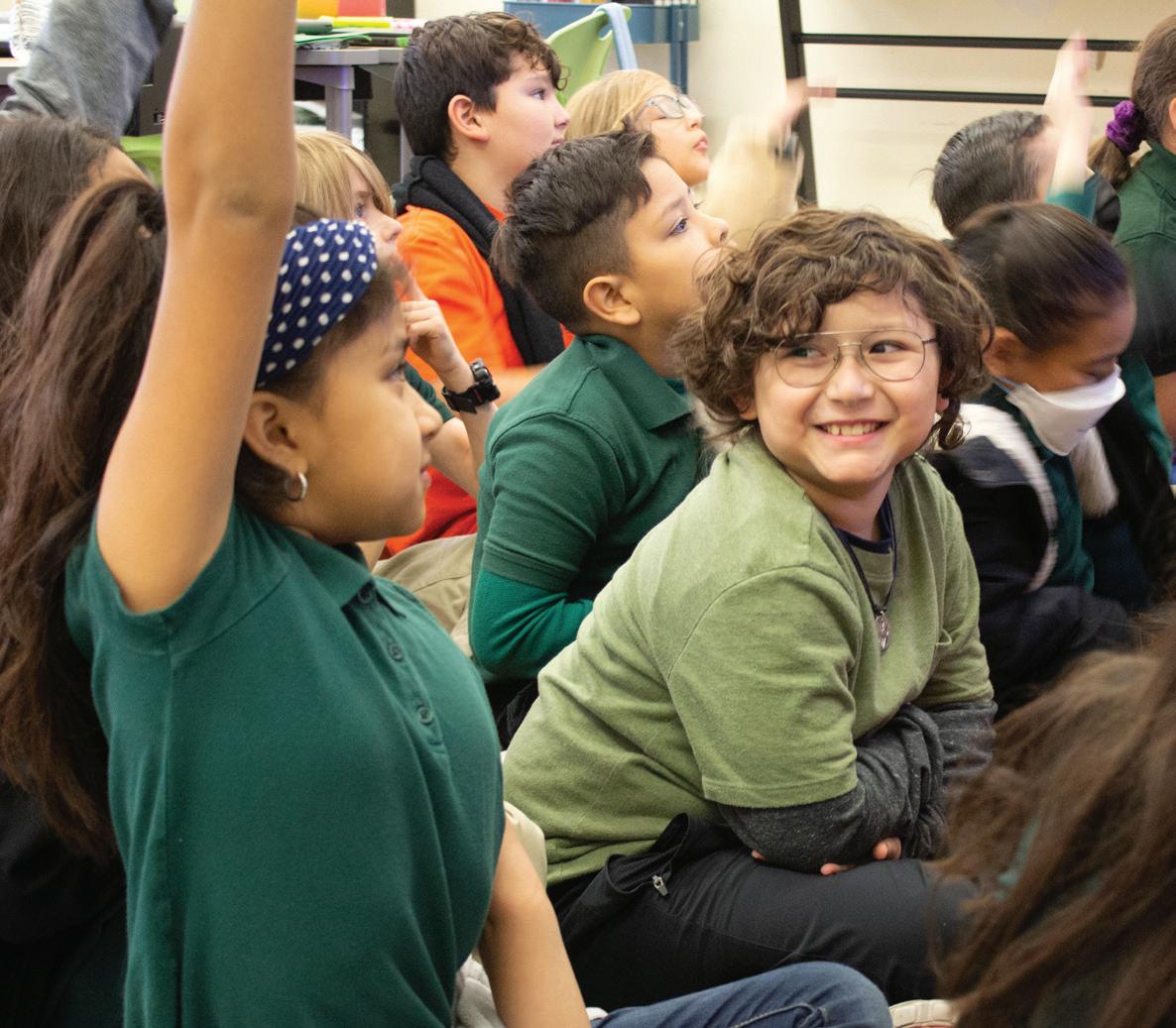
“These schools already had existing dual language programs. The partnership enriched the model by bringing in the time, talent and
resources of UTSA,” Santos says. “They are learning from the best. We are growing our own.”
UTSA faculty are supporting campus teachers by providing resources, professional development and working with the teachers one-on-one. Clinical teachers and graduate counseling students have also had the opportunity to expand their skills at the campuses.

“Once the clinical teachers have had a few weeks to experience the classroom, they gain this confidence,” says Claudia T. Garcia, associate professor of instruction in the UTSA Department of Bicultural-Bilingual Studies. “They are co-teaching and co-planning with their mentor teachers. By the second semester, they are starting to take over.”
Abigail Gamez ’22, a firstgeneration and transfer student, who recently graduated with her
Bachelor of Arts with a bilingual education concentration, is one of the Roadrunners who had the opportunity to be a part of the partnership.
“The partnership between UTSA and SAISD prepared me by having hands-on and inperson practice,” Gamez says. “The program can help with things as small as learning how to make copies to the larger task of learning how to differentiate instruction for each student. Nothing beats actually observing and implementing these effective practices in the classroom.”
With the current teacher shortage, Santos added that it’s important that the partnership focuses on preparing them to not only get hired but stay for a long career in teaching.
“Clinical teachers are learning from master dual language teachers. Our goal is to turn around and offer them a teaching position,” Santos says.S
Being able to say you speak two languages empowers students and gives children cultural, cognitive and economic advantages.Students at SAISD Bonham Academy learn all of their academic subjects in both Spanish and English. Astrid Venegas, a UTSA bilingual education clinical teacher, helps a student with her classwork while Alejandra Guajardo, a seasoned 4th grade dual language teacher, watches and provides support to the teacher.

commencement callout
Business graduate Langston S. Taylor ’22 points to his supporters in the crowd at the Spring 2022 Commencement ceremony at the Alamodome. More than 5,000 graduates earned their bachelor’s, master’s or doctoral degrees that day.

OCTOBER
SEPTEMBER TAYLOR EIGHMY begins tenure as UTSA president.
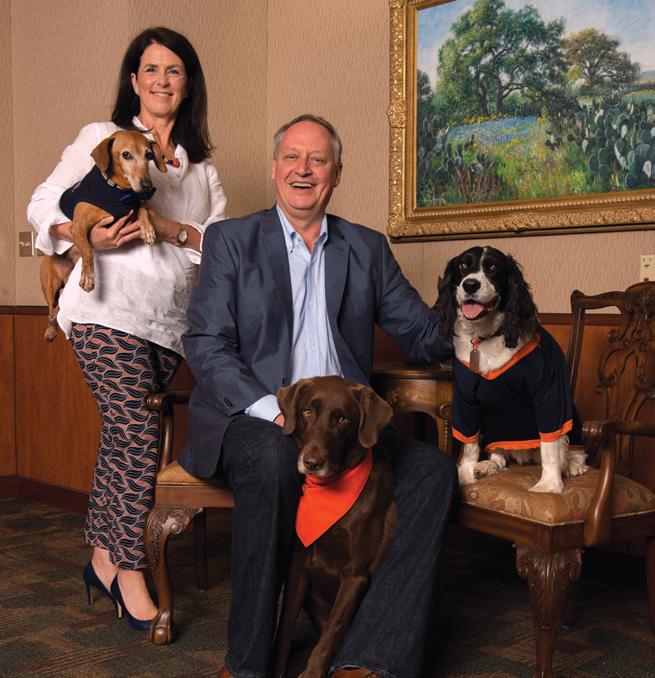
OCTOBER
CLASSROOM TO CAREER INITIATIVE launches and expands students’ hands-on learning opportunities.

APRIL FUTURE OF DOWNTOWN
CAMPUS charted in presidential initiative, advancing urban serving mission.
Eighmy unveils 10-YEAR STRATEGIC PLAN based on student success, research excellence and strategic growth.
AUGUST
PRESIDENTIAL INITIATIVE on Research Excellence unveiled, propelling UTSA’s Tier One efforts.
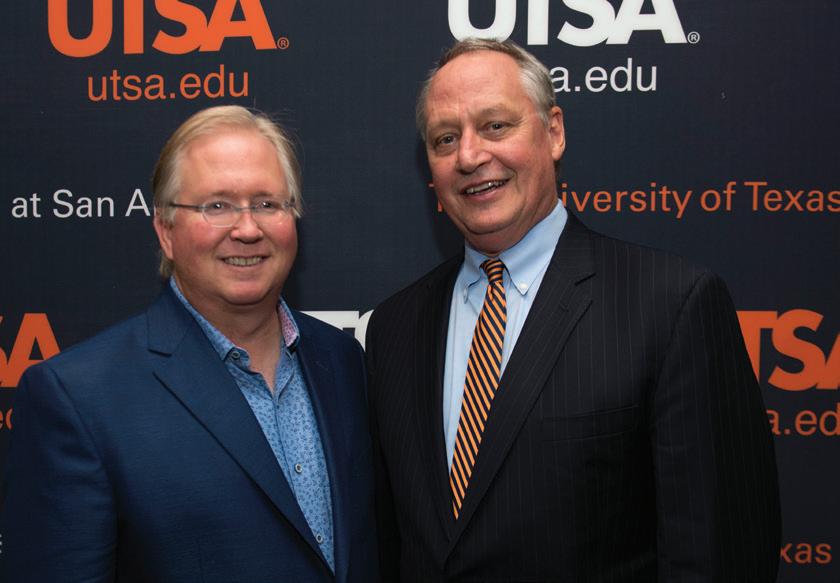
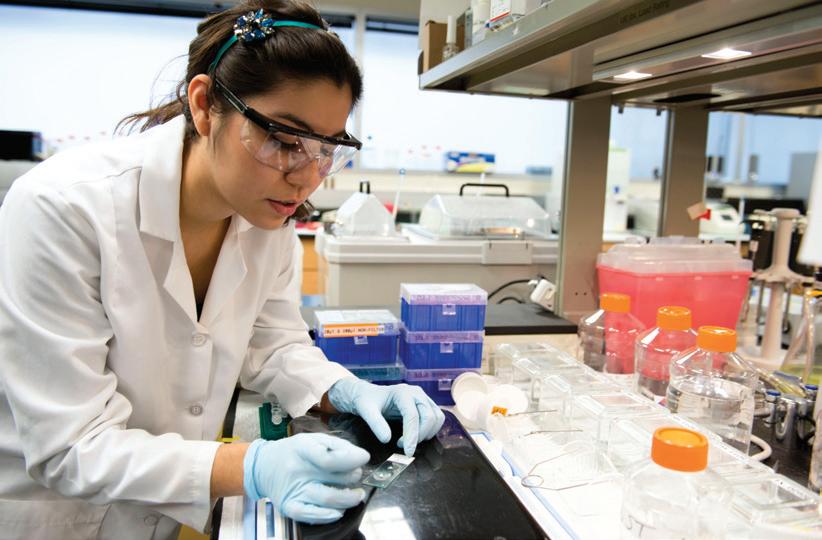
SEPTEMBER
Business leader Graham Weston donates $15 MILLION TO DOWNTOWN EXPANSION; UT SYSTEM REGENTS FUND $70 MILLION.
Through transformational growth and community support, the university is on a trajectory to a very bright future
Taylor Eighmy said in his inaugural address as UTSA’s sixth president. In the five years since, university leaders, faculty, staff, students, alumni, the San Antonio community, and government and business partners have all come together to elevate the university to new heights. Sombrilla Magazine takes a look at how this grand collaboration has paved the way for a new era of prosperity for the university and the Alamo City.
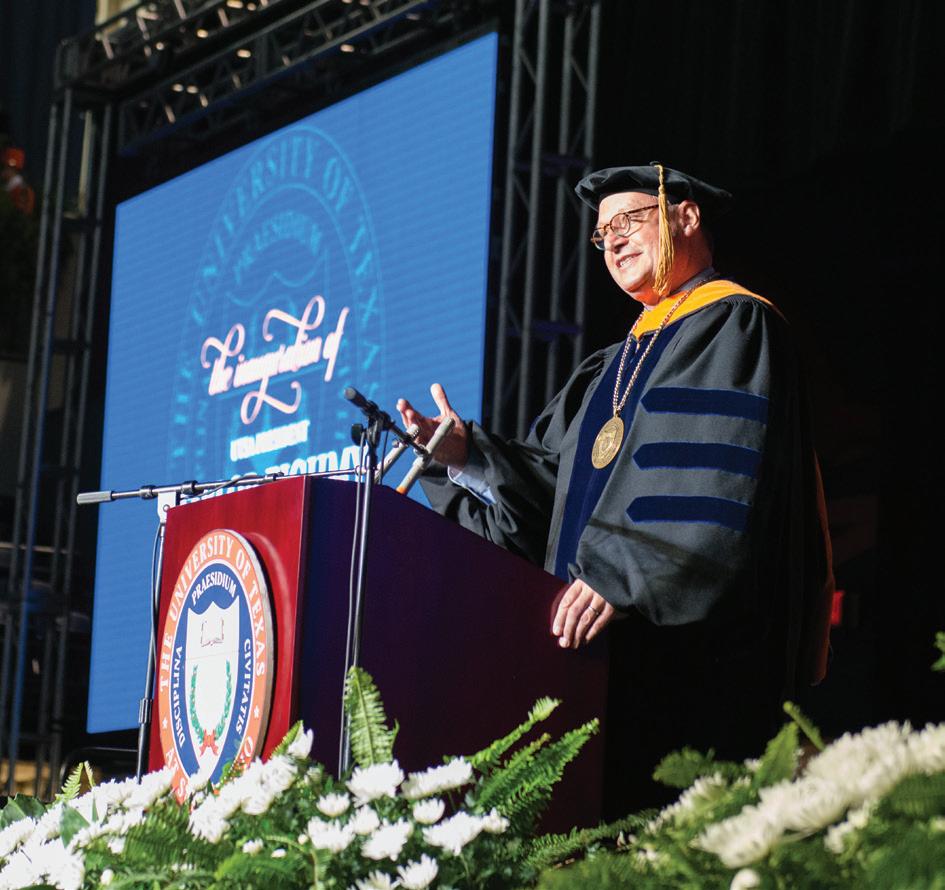
JANUARY
STRATEGIC FACULTY HIRING INITIATIVE created to bolster faculty diversity and expertise.
DECEMBER
UTSA launches Bold Promise, a groundbreaking program that covers 100% OF TUITION AND FEES FOR UNDERGRADS IN NEED.

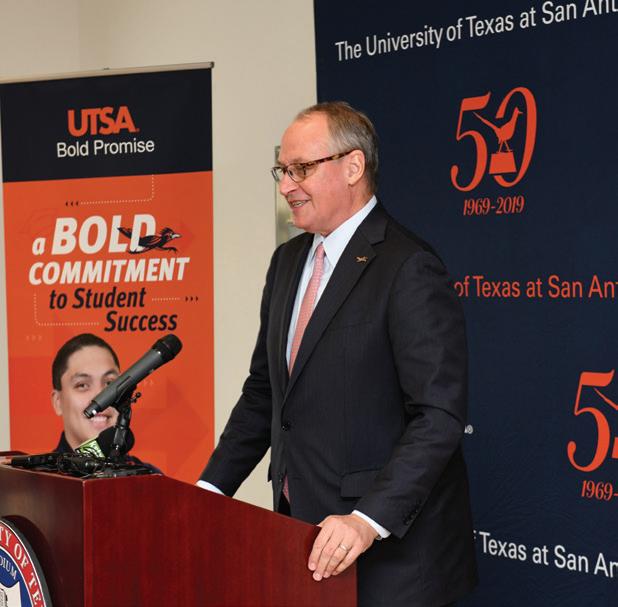
MAY
Department of Energy selects UTSA to lead $111 MILLION CYBERSECURITY MANUFACTURING INNOVATION INSTITUTE (CyManII).


SEPTEMBER
Westside Community Center opens; WESTSIDE COMMUNITY PARTNERSHIP launched to support educational, economic and cultural programs.

OCTOBER
COLLEGE FOR HEALTH, COMMUNITY AND POLICY established to advance studies in human health and community well-being.
AUGUST
SCIENCE AND ENGINEERING BUILDING opens with cutting-edge labs, classrooms and collaborative spaces.
OCTOBER
UTSA earns prestigious SEAL OF EXCELENCIA for commitment and ability to accelerate Latino student success.
SEPTEMBER
Local philanthropist Harvey E. Najim donates $3 MILLION for Najim Innovation and Career Advancement Center.
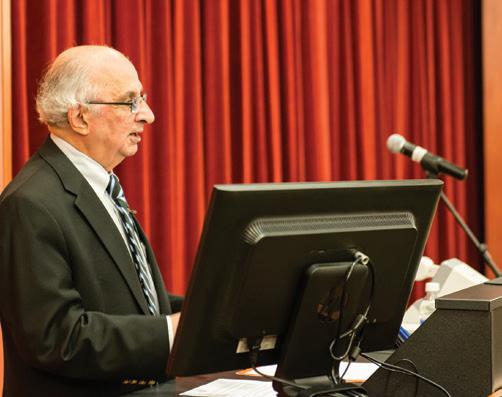
AUGUST
ROADRUNNER ATHLETICS
CENTER OF EXCELLENCE opens, supporting student-athletes’ academic, health, and wellness success.
AUGUST
UTSA achieves record enrollment with nearly 35,000 STUDENTS, and for the first time in history, awards more than 7,400 DEGREES in an academic year.

SEPTEMBER
College of Engineering and INTEGRATED DESIGN launched to promote collaboration among students and faculty in engineering and architecture disciplines.
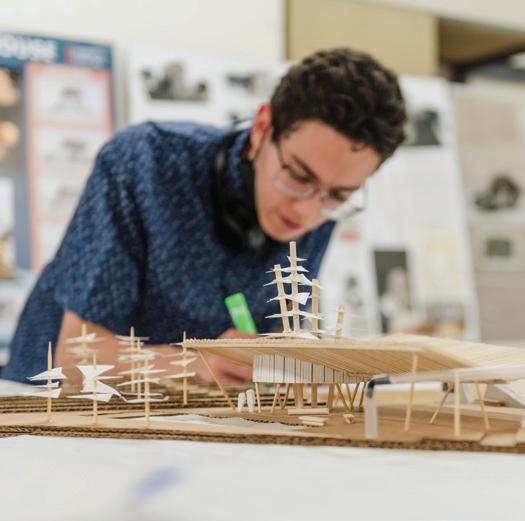
JUNE
UTSA receives $40 MILLION gift from philanthropist MacKenzie Scott, inspired by university’s efforts to advance Latino student success.
MARCH
Carlos and Malú Alvarez give transformational $20 MILLION FOR COLLEGE OF BUSINESS endowed faculty positions and undergraduate research.
OCTOBER
UTSA announces jump to AMERICAN ATHLETIC CONFERENCE as its national stature rises.

DECEMBER ROADRUNNERS
FOOTBALL captures first Conference USA championship.
DECEMBER
Margie and Bill Klesse make $20 MILLION gift for UTSA College of Engineering and Integrated Design student scholarships and faculty endowments.

JULY 2022
UTSA and SOUTHWEST SCHOOL OF ART finalize integration, propelling high-quality arts education in B.F.A. and community programs.
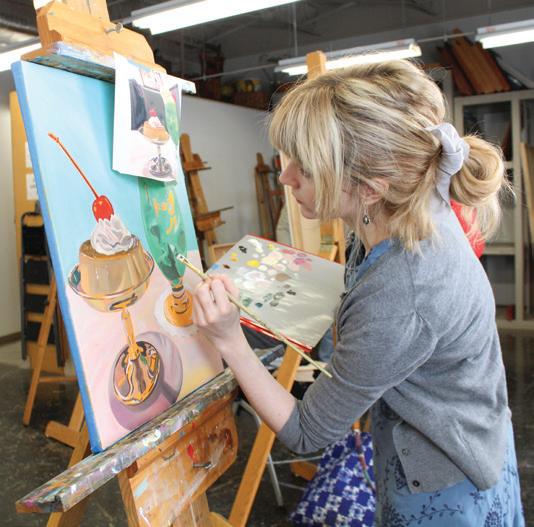
OCTOBER
Be Bold: A Campaign for Our Future launches with $500 MILLION fundraising goal.
JUNE
UTSA becomes a founding member of the ALLIANCE OF HISPANIC SERVING RESEARCH UNIVERSITIES, advancing opportunities for Latino students and faculty.
FEBRUARY
UTSA earns CARNEGIE R1 CLASSIFICATION, adding the university to the nation’s top 4% of research institutions.

JUNE
UTSA and UT Health San Antonio establish joint UNIVERSITY OF TEXAS SCHOOL OF PUBLIC HEALTH SAN ANTONIO
DECEMBER
Roadrunners Football scores second CONFERENCE USA CHAMPIONSHIP; UTSA Soccer captures program's first C-USA championship.
JANUARY
UTSA opens SAN PEDRO I, home to its National Security Collaboration Center and new School of Data Science, growing city’s downtown tech corridor.
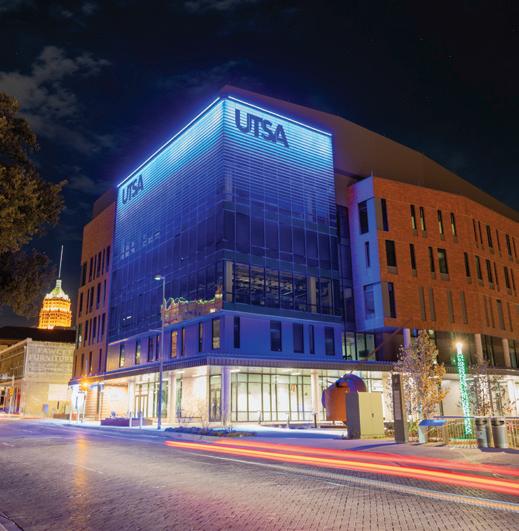

NOVEMBER
The UT System Board of Regents approves new INNOVATION, ENTREPRENEURSHIP AND CAREERS building, UTSA’s next phase of downtown development.
The world is currently embracing space exploration with a fervor not seen since the Space Race of the 1960s. Findings from the James Webb Space (JWST) and Event Horizon telescopes have wowed the public at the same time that dozens of commercial players have made serious investments in space development. Life beyond Earth is becoming more approachable and research advances are bringing galaxies far, far away closer than ever.
UTSA has played a significant part in those breakthroughs. From black holes and stardust to lunar colonies and smart habitats, scientists, engineers and students at UTSA are gaining momentum in international efforts to answer questions we’ve been wondering about our galaxy and the broader universe for generations.
Many of these Roadrunners briefly took their heads out of the stars to share their brilliant stories with Sombrilla Magazine.


Scientists across several departments at UTSA affectionately refer to the JWST as the “Just Wonderful Space Telescope,” and it’s easy to see why. From the Carina and Southern Ring nebulas to Stephan’s Quintet, the reveal of the telescope’s first images could only be described as breathtaking — even for seasoned astronomers.
“I knew that there would be much deeper images and much better-quality images. Intellectually, I knew that. But nothing prepared me for actually seeing the beauty of these images — both from an artistic point of view, but also a scientific point of view,” says Chris Packham, a professor in the UTSA Department of Physics and Astronomy.
The JWST operates with advanced infrared capabilities and boasts a 21-foot gold-plated beryllium mirror that allows it to capture more light than the Hubble Space Telescope. Astronomers use data from both instruments to assemble deeper and sharper images than ever before. Perhaps no image was more mind-blowing than the deep-field photo of SMACS 0723, a cluster teeming with thousands of galaxies, which are each in themselves a collection of roughly 100 billion stars.
“If you put a grain of salt or a grain of sand on the tip of your finger and held it at arm’s length, that would be how much sky is covered in this single image,” Packham explains. “There’s no such thing as blank sky anymore. There’s always a galaxy there. It’s just a total gamechanger in how we do astronomy.”
Packham is co-leading an international team known as Galactic Activity, Torus and Outflow Survey (GATOS), which is studying interactions between several black holes and their host galaxies at different life stages to learn more about how galaxies are formed.
In a similar vein, UTSA astrophysics professor Thayne Currie is using JWST data to learn more about the compositions of various exoplanets, which are planets outside of solar systems that orbit another star. Going forward, Currie hopes to use the JWST to reveal images of exoplanets more like those in our solar system and potentially habitable worlds.
“The direct-imaging capabilities of the Webb Telescope may be even more powerful than we anticipated, allowing us to study planets at wavelengths where it is difficult to image them from the ground,” Currie says.
Both professors say the JWST could keep them and other UTSA researchers busy for the next two decades or so. The telescope’s exploration of supermassive black holes, distant stars and unique planets around the universe, in particular, could fundamentally change science forever.
The endless universe surrounds us, but mankind has long known very little about it. That’s starting to change thanks to recent international discoveries that have fundamentally altered our understanding of galaxies, black holes, stardust and so much more. Innovative research at UTSA has been vital to these major breakthroughs and will continue to be essential for many years to come.

n May of 2022, a picture of the monstrous black hole at the center of our galaxy was captured for the very first time, and UTSA physics professor Richard Anantua was
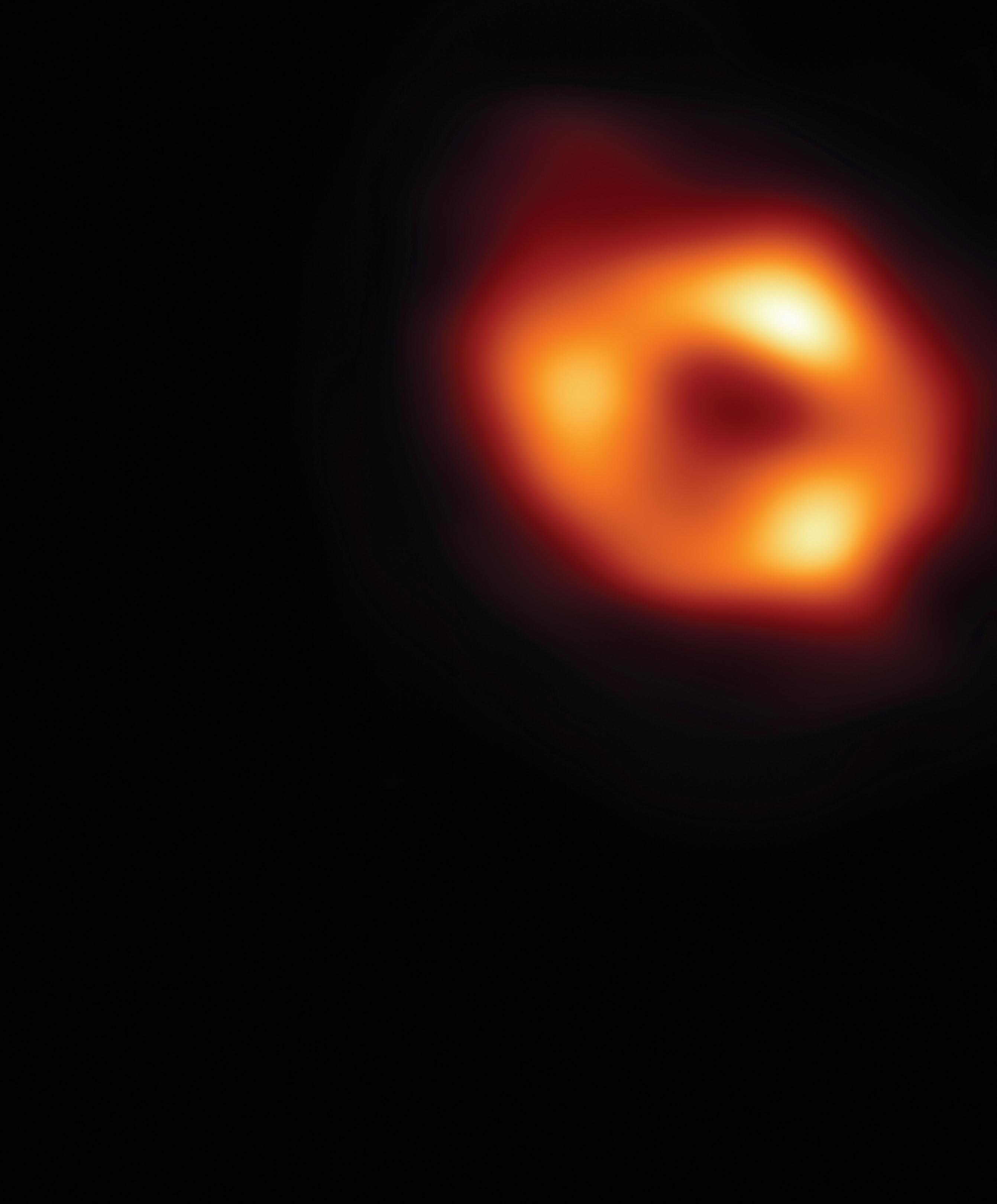
part of the international team that made it happen. Anantua is a member of the Event Horizon Telescope (EHT) Collaboration, a worldwide research collective that interpreted the groundbreaking image of the black hole known as Sagittarius A*. It was only the second time in history a black hole image had been produced.
“Imagine how an astronomy textbook would have evolved over time. For hundreds of years, there are figures of stars, planets and moons, and there are pretty pictures of Saturn’s rings,” Anantua says. “But for the first time, now, we can have pictures of black holes in our astronomy textbooks.”
Anantua’s models of the plasma physics flowing around Sagittarius A* helped make
the image possible. Black holes are a source of gravity so strong that not even light can escape, which makes them impossible to see by any conventional measure, but they do discharge super-heated, swirling masses of plasma that form a ring around the black hole’s center.
Take a look at the image of Sagittarius A* and you’ll see the rings have glowing chunks in different places. These chunks are where the plasma is hottest — and that’s where Anantua’s research interest lies. His turbulent heating models were more successful than the thousands of others submitted around the world in providing explanations for the plasma heating detected around Sagittarius A*.
Black holes have been known to consume planets like a football team visiting a buffet, but Anantua says we need not worry about Sagittarius A*. It’s still a distant 26,000 light years away, and luckily
for our solar system, it has a comparably low appetite.
“It might eat one sun’s worth of mass every 100,000 years even though it’s 4 million times the mass of our Sun,” he says. “So, that’s quite an extreme diet.”
Building from his contributions to the remarkable image, Anantua is now in the midst of launching the state’s first Event Horizon Telescope group at UTSA. He and a team of graduate students will focus on creating more types of simulations to decipher what’s swirling around black holes and exploring how certain events alter a black hole’s diet.
For hundreds of years, stardust was just the stuff that got in the way of astronomers hoping to catch a glimpse at planets, distant galaxies and black holes. But one UTSA researcher is showing everyone just how essential that dust has been to the history of the universe — and how it could be essential to Earth’s survival in the future.
Dr. Angela Speck, professor of astronomy and chair of the UTSA Department of Physics and Astronomy, is one of the world’s leading stardust researchers. Speck was recognized by the American Association for the Advancement of Science in 2022 for her contributions to our understanding of the effects of stardust across the cosmos. She has also earned funding from NASA and the National Science Foundation to uncover the mysteries behind this material ejected by dying stars.
“Now we’re seeing that it’s really important to understand dust because it affects everything,” Speck says. After all, she adds, each and every living being is essentially composed of the elements of stardust. “The first generation of stars only contained hydrogen and helium and nothing else. Why? Because everything else was born inside stars.”
The study of stardust sits in a unique pocket of astronomy that intersects with material science,
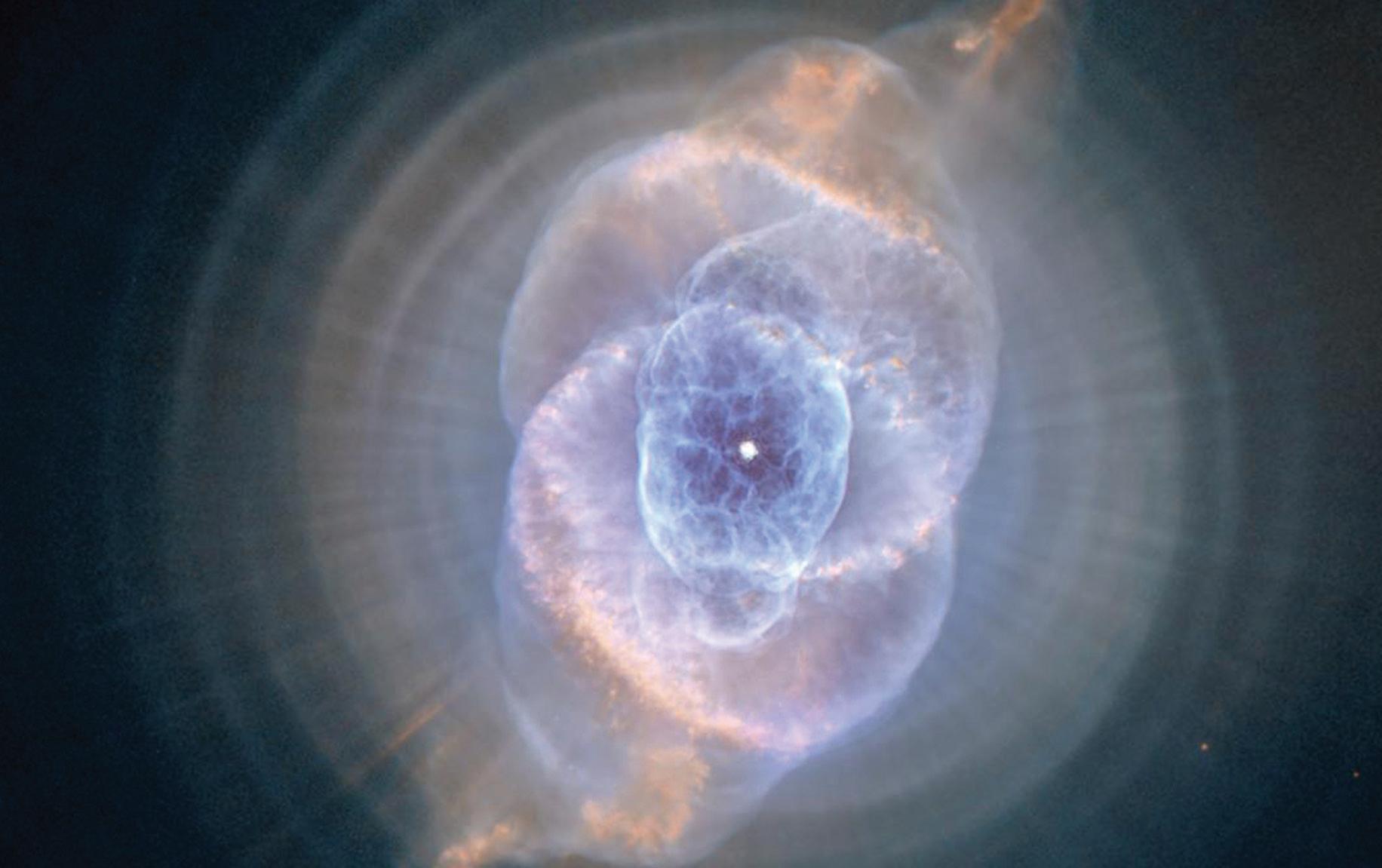
geology and chemistry. Speck examines the naturally occurring space substance from a distance through infrared astronomy, then analyzes its molecular composition, mineral qualities and how the dust shells morphed over time. The impurities of the dust grains are fundamental to understanding how and when galaxies were forged.
“Depending on what a particular dust is made of — and by that, I mean everything that’s in it — that will tell us how quickly certain stars formed,” Speck says.









More than anything, Speck’s stardust research focuses on how the material interacts with light, and that could have huge ramifications here on Earth as the planet’s temperature continues to rise. Speck is doing foundational research into using stardust to cool the planet. Greenhouse gases in the atmosphere absorb infrared radiation and cause temperatures to rise, but if a small amount of stardust were shot into the stratosphere, it could reflect just enough sunlight to give Earth a few degrees of much-needed relief.
Speck admits that much more data will be needed about the long-term effects such a plan would have on visible light and the ozone layer. It would be years, or possibly generations, before it’s implemented. “It’s not something I’ll see in my lifetime, but we’re laying the groundwork,” she says. “We’re going so far beyond classic astronomy.”
UTSA is a member of the Association of Universities for Research in Astronomy (AURA), a select group of institutions that operate worldclass observatories on behalf of NASA and the National Science Foundation. AURA’s Space Telescope Science Institute is responsible for the science missions for the Hubble Space Telescope and the JWST. UTSA provost Kimberly Andrews Espy has served on AURA’s board of directors for six years, while Speck and Packham serve as representatives.
 DR. ANGELA SPECK
Layers of stardust shells surround the Cat’s Eye Nebula, one of the first planetary nebulae to be discovered.
PHOTO COURTESY OF NASA AND STSCI
DR. ANGELA SPECK
Layers of stardust shells surround the Cat’s Eye Nebula, one of the first planetary nebulae to be discovered.
PHOTO COURTESY OF NASA AND STSCI
It’s no longer just some pipedream from the cartoon “The Jetsons.” Colonization of the Moon, and even Mars, appears to be inevitable. And while getting there is one thing, living there is another. Creating a sustainable society on the Moon or Mars presents tremendous challenges, but UTSA is leading the charge to come up with solutions. Collaborating, building, repairing — we’ve got it covered.
sheepish grin comes over the face of Dr. Alan Whittington from his lab at UTSA’s Multidisciplinary

Studies Building. “What we do here is really unusual,” admits the professor who specializes in planetary geology. “There aren’t many labs in the U.S. that apply the equipment we have to the things that we do.”
But doctoral student Brenna Halverson doesn’t think it’s unusual at all. “I get to make moon lava,” she says. “Come on. How is that not awesome?”
Whittington and his team have studied moon rock melting points, viscosity and other properties for the last two years to further a NASA-funded joint venture with San Antonio’s Astroport Space Technologies aiming to build


launch pads and other structures on Earth’s Moon.
Transporting physical building materials to the Moon would be massively expensive, so Astroport and UTSA are contributing to an alternative: Melting moon soil — better known as regolith — to create building bricks. The process requires an instrument called an induction furnacenozzle and a 3D printer to form and place lunar regolith bricks, but before that can happen, Whittington has been identifying the temperatures in which moon soil liquifies and examining the strength of the hardened product.
It’s a challenging task because each lunar simulant recipe leads to a different result. The surface of the Moon is comprised largely of basalt, but the far side of the moon is comprised primarily of feldspar.
“It’s sort of like the Colonel’s 11 different herbs and spices. Each one has their own little flavor,” he jokes while sorting through a drawer full of lunar simulant bags and containers.
The researchers heat each simulant for 20 minutes in the lab’s furnace at temperatures sometimes exceeding 3,000 degrees Fahrenheit until it’s completely molten. The sample glows a brilliant orange as it’s poured before solidifying into a black glass. Their continuing
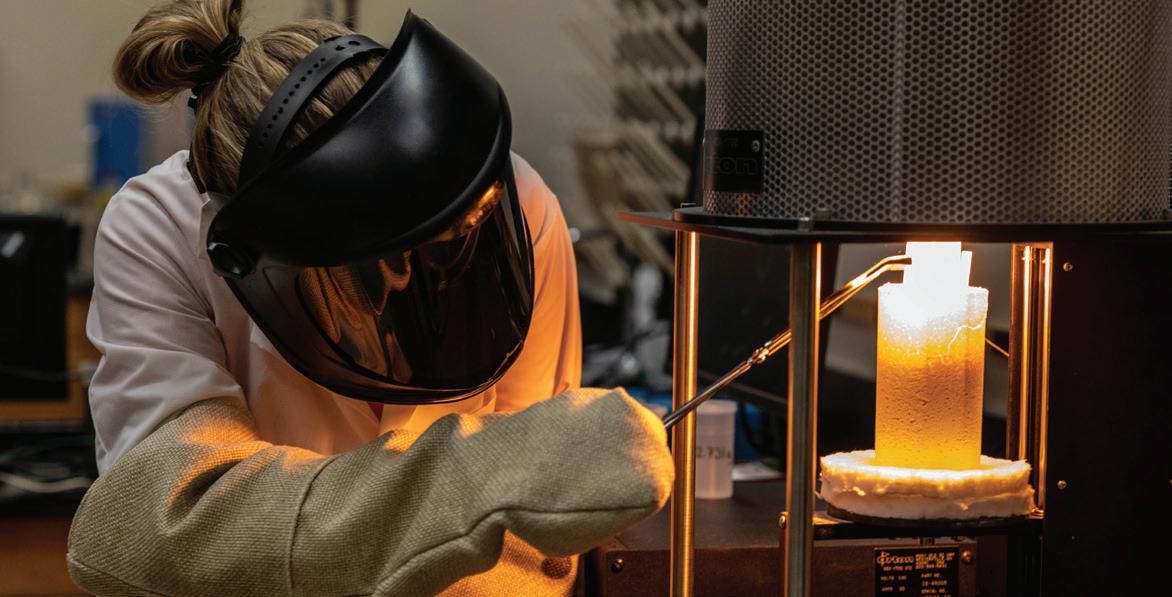
aim is to identify the right convergence of factors that will result in solid bricks that can be large enough to be useful for building, won’t crack upon cooling, and can withstand extremely hot rocket blasts.
UTSA civil engineers Sazzad Bin-Shafique and Ibukun Awolusi are also working on the next step. They recently began developing transportation technologies that would deliver excavated regolith to Astroport’s Lunatron bricklayer system.
DR. ALAN WHITTINGTON This rendering depicts a lunar launching pad being constructed using bricks made from melted moon soil.If you’ve ever watched “Gravity” or “The Martian,” you know that there’s an ever-present risk to existing in outer space: extreme events. In a matter of seconds, dust storms, quakes, meteorites or a plethora of other threats can cause structural or engineering damage that presents a lifethreatening circumstance.
“You can’t call up a repair company or go to Home Depot in space,” says Dr. Arturo Montoya, an associate professor who holds a dual appointment in the Departments of Mechanical Engineering and Civil and Environmental Engineering.
To prevent issues from becoming emergencies, researchers at UTSA, Purdue
and the University of Connecticut are developing smart, survivable space habitats as part of a fiveyear, $15 million NASA study. Montoya is leading UTSA’s efforts in what is formally known as the Resilient Extra-Terrestrial Habitats (RETH) Institute.

“The focus of our team is to create a resilient framework for the design of space habitats. And the key word there is resilient,” Montoya says. “Things will go wrong, so for the structure to be resilient, we need to figure out everything that can go wrong. We need to be ready to respond in a short amount of time because time is critical up there.”
Montoya and his students are developing flexible computer
models that can recreate extreme space conditions for cyberphysical testing. These unique modeling platforms will provide fertile ground for the smart habitat’s network of sensors, which will actively learn, detect and swiftly diagnose issues. From there, the resilient habitats will incorporate autonomous robots that can either operate independently or collaborate with human users to make repairs and address other issues.
Montoya often discusses the RETH Institute’s efforts with students of the Margie and Bill Klesse College of Engineering and Integrated Design, as a vast cross-section of engineers will be needed to tackle the challenges of the future. The

smart habitats they’re developing need architects, civil engineers and construction managers to create habitat structures, interior designers to foster cozy internal environments, chemical engineers for preserved foods, biomedical engineers for medical devices, electrical engineers for power, computer engineers for communication with Earth and mechanical engineers for air pressure and thermal systems.
“You have to develop the techniques we have in place for Earth structures, but think outside the box,” he says.
In addition to serving as the senior program manager of research and development at the Southwest Research Institute, Kurt Retherford is an adjunct faculty member in the UTSASwRI Space Physics Graduate Program. Retherford was the principal investigator for a research team that recently found that volatile chemicals and compounds frozen in ice on the Moon’s South Pole were very likely delivered through a comet impact.
Space exploration and habitation are tremendously big endeavors that are already requiring a large workforce. Through unique research efforts, UTSA is giving its science and engineering students the skills and real-world experience they need to not only fulfill significant needs in the aerospace industry but also thrive in those positions.
events on Earth that can translate to space research.
Habitats aren’t all that need to be prepared for the various extremes of outer space. People do, too.
The NASA MIRO Center for Advanced Measurements in Extreme Environments at UTSA — or CAMEE — is dedicated to just that.
Working with big data recorded by rovers, taking oceanic and volcanic measurements, and crafting high-fidelity turbulence models, CAMEE faculty and students explore the extraterrestrial environments of the Moon and Mars alongside extreme climate
An artificial Martian landscape lines the rotunda floor of the CAMEE offices. Here, students test out the 3D-printed rovers they’ve designed to see how they’ll traverse the rocky, red surface. One team, for instance, is trying out rover wheels fitted with a series of rollers that can make precise stops and work the vehicle out of jams. Another interdisciplinary team of students even dreamt up a rover with crustacean-like qualities for a NASA proposal in 2021.
UTSA received an initial $3 million from NASA in 2019 to develop CAMEE. The center trains a diverse group of undergraduate and graduate students to become highly

skilled professionals in STEM disciplines that support NASA’s mission, from measurements to modeling to data fusion. In fact, four CAMEE students have served as NASA interns this year, gaining hands-on experience with Mars rovers, jet propulsion, vegetation and aerodynamics.
Doctoral student Mansi Joshi was one of them, earning the Future Investigators in NASA Earth and Space Science and Technology Fellowship. Growing up, Joshi says she was always intrigued by space science and satellites. UTSA has given her the opportunity to live out that fascination. Her current research uses various types of satellite data to learn more about sea ice and the impacts of climate change.
“It has surely boosted my confidence,” Joshi says of earning the highly competitive NASA fellowship. “I hope to use it to go for summer schools and attend different conferences in my field to build connections and hopefully learn the art of collaborative research.”
CAMEE recently received a $2 million renewal grant from NASA, which will support a new laboratory where students will be able to incorporate virtual reality modules and additional 3D-printed robotics into their projects. CAMEE also aspires to add a vacuum tunnel for drone testing in addition to a small-scale replica Moon habitat with a domed structure on the UTSA campus.

One high-profile space drone will be on the mind of Dr. Xinting Yu, an assistant professor in the Department of Physics and Astronomy who started at UTSA in January, for many years to come. She’s studying atmospheric and surface material properties on Titan, the largest of Saturn’s moons and the only moon in our solar system that boasts an atmosphere. Titan’s atmosphere is made mostly of nitrogen, like Earth’s, with a hint of methane. Yu seeks to learn more about this mysterious source of methane in the lead-up to NASA’s Dragonfly rotorcraft drone landing on Titan in 2034.
 Students from the UTSA Hypersonics Lab pose next to the university’s Mach 7 Ludwieg Tube Wind Tunnel.
Students from the UTSA Hypersonics Lab pose next to the university’s Mach 7 Ludwieg Tube Wind Tunnel.
hat with Dr. Chris Combs about the aerospace industry, and he’ll quickly tell you about how the Lone Star State leads the way. “Every major manufacturer is here,” says the Dee Howard Endowed Assistant Professor in Aerodynamics at UTSA. “We’re a central hub for all sorts of aerospace work, there’s a major defense presence, and all of these different space companies have popped up in Texas — SpaceX, Blue Origin, Firefly, you name it.”
There were more than 90 aerospace job listings in San Antonio alone during the last year, but until fall 2022, there was no aerospace program in the city. That’s changed now that Klesse College has launched the M.S. degree in aerospace engineering
at UTSA. Students in the program are working directly with Combs in the UTSA Hypersonics Lab, which features a 60-foot Mach 7 Ludwieg Tube Wind Tunnel, one of only five facilities at an American university capable of testing objects in flight at Mach 7 speeds. Unlike many of its peers, UTSA’s facility is also capable of free-flight testing.
“We can measure things like lift, drag, pressure and temperature on the object’s surface to help understand how vehicles are going to behave at that kind of speed,” Combs explains. “You get 20 milliseconds or so of this thing flying, so you get a lot of really powerful data out of it before it ends up in our vacuum tank at the end of the test.”

Twenty milliseconds may not seem like a lot of time, but high-speed acquisition cameras

capture the footage at 2 million frames per second, logging enough images to result in a 15-minute video that can be studied. UTSA’s aerodynamics researchers can also use a variety of test gases to replicate flight in environments other than Earth’s, whether it be Mars or a distant exoplanet. This unique nexus of capabilities has placed the UTSA Hypersonics Lab in high demand. The lab has already logged well over 400 tests in the last two years, including several for NASA. The Hypersonics Lab also collaborates frequently with Dr. Daniel Pineda and the UTSA Laser Spectroscopy and Chemical Propulsion Laboratory. Among many projects in this lab, Pineda and his students test rocket engines for advanced propulsion research, which incorporates thermodynamics, fluid mechanics,

chemistry and mechanical design. And because all UTSA aerospace students work handson in every aspect of the facility’s operation, they’re landing jobs immediately upon graduating — from Aerospace Corp. to Axiom Space to the Johns Hopkins Applied Physics Laboratory. Much like every other space-related research venture at UTSA, the momentum has been undeniable.
“We’ve built from the ground up something that’s become a national resource,” Combs says.S
DR. CHRIS COMBS Graduate research assistant Angelina Andrade places a test rocket in the wind tunnel and makes adjustments.From documenting San Antonio’s extensive music histories that illuminates the important issues of today.
to showcasing culture through hip-hop and breaking barriers cultural roots of the community and the music for Mexican American music, UTSA is preserving the
hen people talk about the Westside community in San Antonio, they think of the vibrantly colored murals they see when driving over the Guadalupe Street bridge. They think of the Our Lady of Guadalupe veladora that watches over the community or the smell of puffy tacos that infuse the air when driving past Ray’s Drive Inn.
What many don’t always think of is the music that was born in the casitas on the West Side more than 60 years ago.
In the 1950s, local Westside teenagers strived to emulate the musical sounds that were sweeping through San Antonio via “the collision of sound” coming in from Louisiana, the East Coast and up north. The teenagers took the notes they heard from genres such as swamp pop, jazz, doo-wop, R&B, blues,
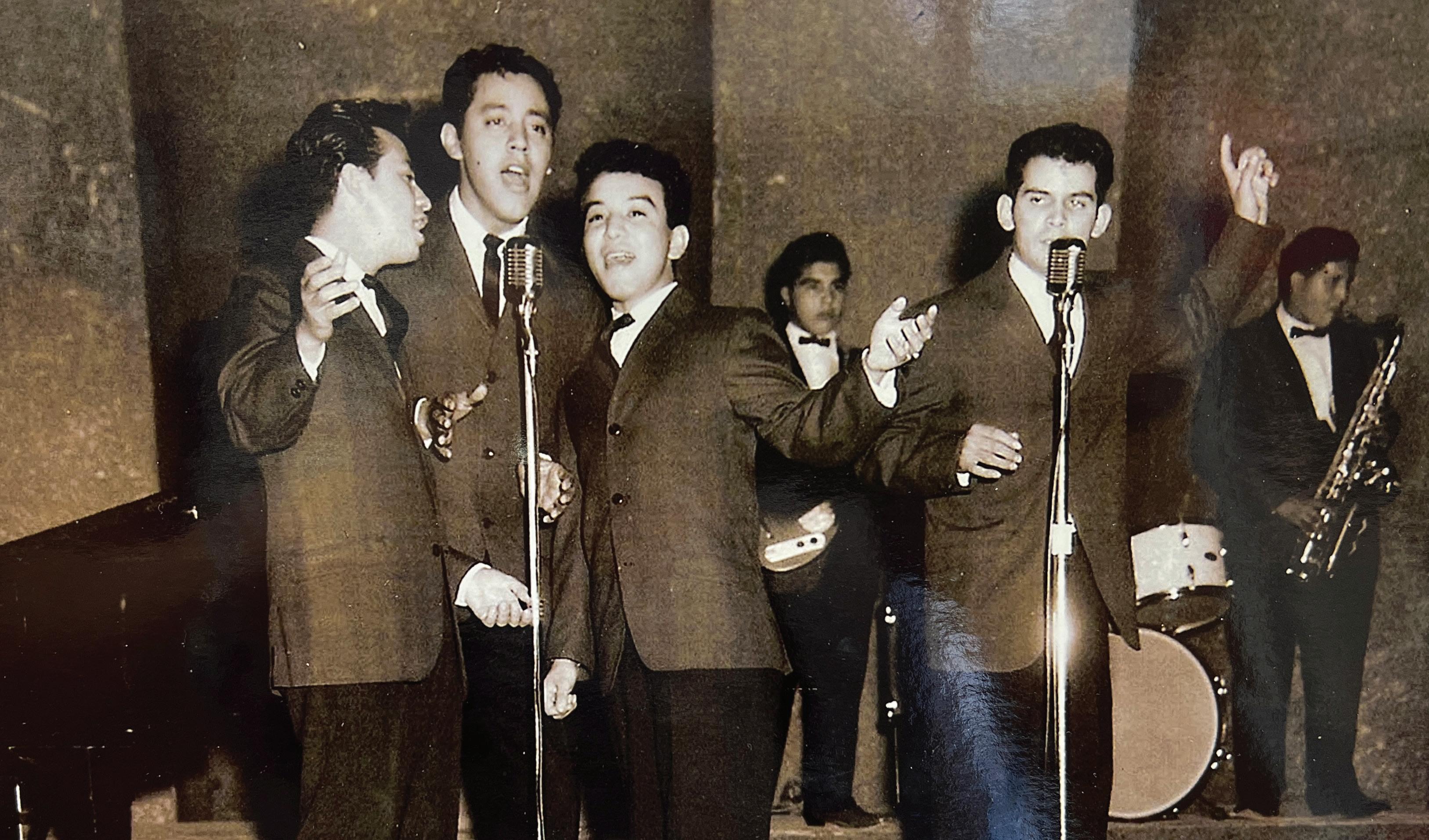
country and rock n’ roll, added their spin and created what today we know as West Side Sound — sometimes referred to as Chicano Soul.
“DJ and West Side Sound musician Henry ‘Pepsi’ Peña, who has the ‘San Antonio Oldies Show,’ talks about how these trains from around the U.S. were carrying different music genres and collided on the Westside,” says Gloria Vasquez Gonzáles, a lecturer and co-director of the UTSA Mexican American Studies Teachers’ Academy. “When the trains collided, the notes went all over the place. The Westside teenagers picked up these notes and made the West Side Sound.”
“It’s done our way because of who we are. It can’t be duplicated exactly, so that’s what makes it unique. All of these influences are in there but done our way — Chicano style,” Vasquez says.
Today, Gonzáles, Sylvia Mendoza, an assistant professor in the UTSA Mexican American Studies program, and several community partners want to preserve the history of the West Side Sound through an oral history collection of photos and recordings.
With an urgency to document these musicians’ histories and a $5,000 grant from the UTSA Westside Community Center, Mendoza and Gonzáles launched the West Side Sound Oral History Project. Beginning in early 2022, it has since evolved from a simple list of names to dozens of community members eager to share their own West Side Sound memories.
“It has expanded in a sense that a lot of people want to tell their story. They want to talk about someone in their family or themselves,” Mendoza says. “I think folks want to see that representation in history. We have been contributing and creating, and I think it excites folks to see something coming out of a barrio in San Antonio.”
West Side Sound developed during a difficult time for the Mexican American community. While the teenage years are supposed to be about having fun, many were instead dealing with the start of the Vietnam War, the Chicano Movement, San Antonio’s Edgewood High School walkouts and trying to find where they fit in society.
“They didn’t want to listen to the Spanish music their parents listened to because they have heard that all their lives,” Gonzáles says. “They wanted to play the music they were hearing on the radio and in clubs. These teenagers switched out the accordion of their parents’ music and instead used trumpets and organs to create a unique sound. They were rebelling and looking for an identity.”
“It was their way of saying ‘This is who I am and who we are.’ I think they took pride in that. They were, of course, more aware of what was going on and were not putting up with it,” Mendoza says.
Aside from what they heard on the radio, the students also took notice of the music that was coming through San Antonio, including performances in what was then called the Chitlin Circuit. This was a group of venues that provided a space for Black artists to perform during racial segregation.
“San Antonio was one of the few cities that had integrated night clubs, some of them Black-owned,” Gonzáles says. “The teenagers would visit these clubs and listen to the music. They weren’t supposed to, but they did.”
One of the clubs was The Keyhole Club, which called itself the first integrated club in San Antonio, Mendoza says.

It’s believed that San Antonio’s status as Military City USA also played a large role in the musical influence, Mendoza adds. San Antonio’s military tradition meant that servicemembers, especially African Americans from places like Detroit, Chicago and New York, mingled with San Antonio’s Latino population.
From there, these teenagers took to their garages and developed their one-of-a-kind sound.
“They weren’t professional musicians but what we called garage bands. A lot of the students were in their high school’s band program, and since their parents couldn’t afford some of the other instruments, the schools were able to get discounts or buy trumpets and saxophones,” Gonzáles says.
“Those instruments are the unique characteristic of West Side Sound. Everyone we interviewed talked about the horns and the brass.”
While many of the teens were from the Westside high schools, the West Side Sound could also be heard in bands or groups that were formed in other areas of San Antonio such as on the Southside and the Eastside.
Many of the early pioneers of the West Side Sound include The Royal Jesters, Sunny & The Sunliners, Randy Garibay and Doug Sahm.
PHOTO COURTESY OF UTSA SPECIAL COLLECTIONS The Keyhole Club, owned by jazz bandleader Don Albert, was located on the corner of Pine and Iowa Streets and is said to be the first integrated nightclub in San Antonio. Young teenagers from the Westside would sneak in to hear the music being played there.When the trains collided, the notes went all over the place. The Westside teenagers picked up these notes and made the West Side Sound.
While the genre is still very popular among the individuals who grew up with it, West Side Sound has now found itself in the ears of a new generation.
“On any given night you can go to Amor Eterno and somebody is spinning vinyl and it’s West Side Sound stuff,” Mendoza says. “You can go to Jaime’s Place and Squeezebox and they still have young people half my age listening to music that came out in the '60s.”

Many of these younger individuals are becoming the knowledge keepers of this particular genre, Mendoza says.
“They have the collections and know how much these albums are selling for on the Discogs website,” Mendoza says. “I didn’t expect a lot of the younger people to be doing historical and archival research about West Side Sound.”
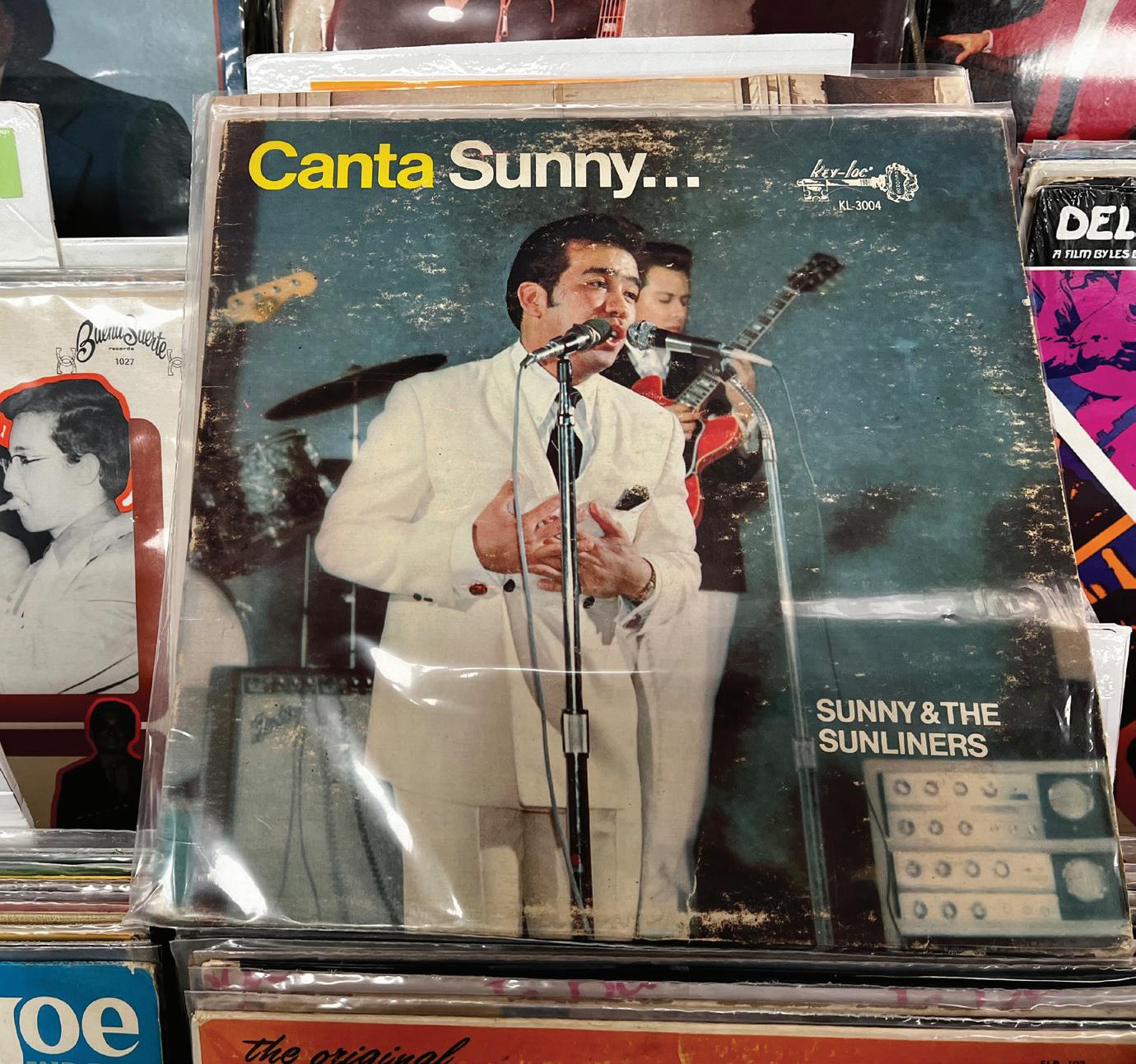
Gonzales adds that she believes the younger generation has taken to the West Side Sound because it’s a sense of pride for them as Mexican Americans.
“I think with this UTSA project and Mexican American Studies, it’s so important to know our history so we can feel empowered,” Gonzáles says. “It lets us know who created our music or who led the student walkouts. I think seeing that allows people to see that in themselves and know they can do that too. It makes them say, ‘I don’t have to assimilate and I can hold onto my identity.’ I think that’s why I feel the project is so important.”
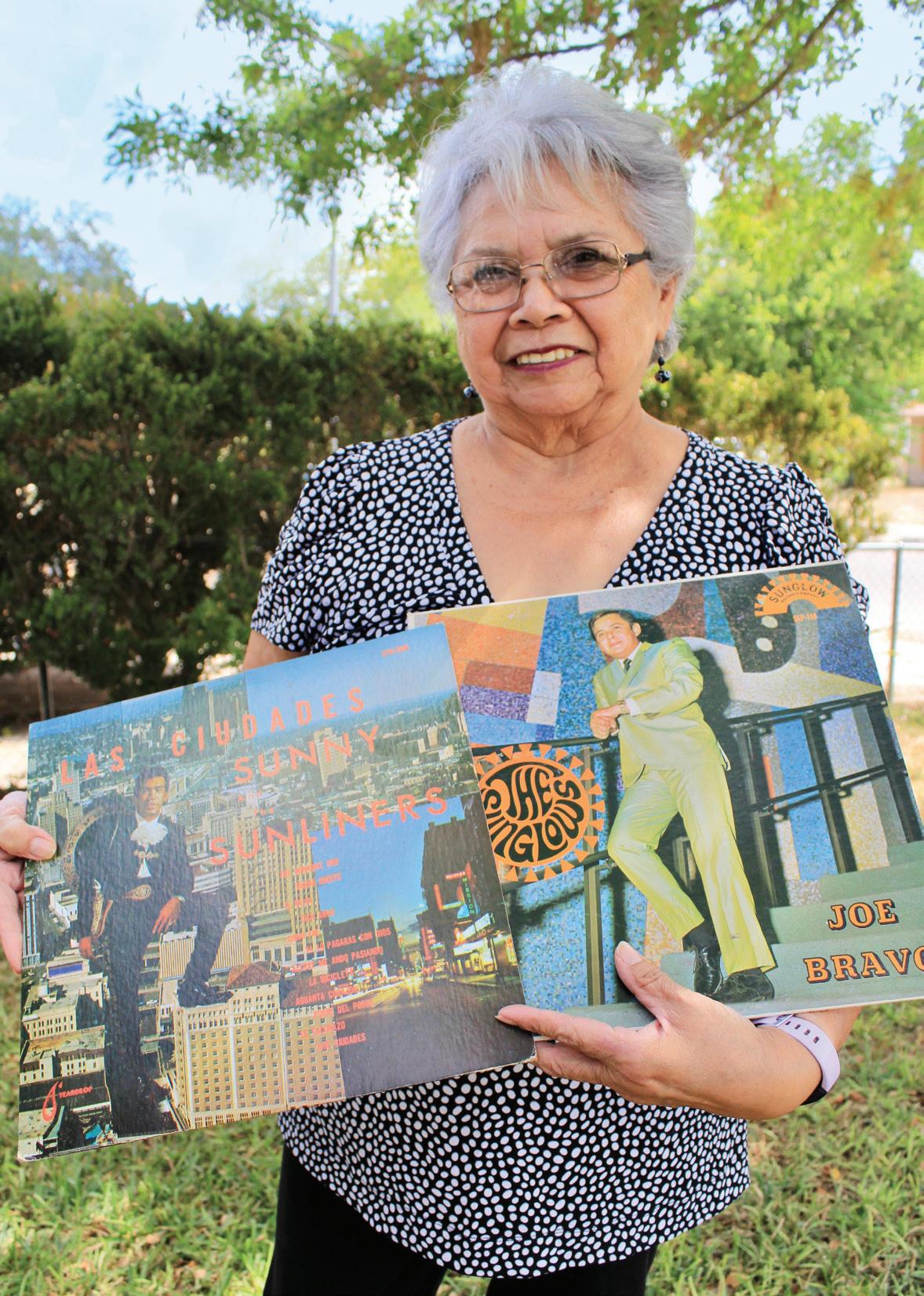
From the iconic accordion playing of Flaco Jiménez to Lydia Mendoza’s guitar talents and the local punk rock scene, San Antonio is a city at the intersection of many musical genres.
An upcoming book called The History of Music in San Antonio from the newly established University of Texas at San Antonio Press, is looking to share and preserve the history of San Antonio’s rich music scene. The project is a collaboration between the UTSA Libraries, the Institute of Texan Cultures and the UTSA School of Music.

Mark Brill, William Glenn and Stan Renard, all editors of The History of Music in San Antonio , describe the city’s music scene as a mixture — a menudo — of all its different elements.
“San Antonio’s ethnic groups are diverse, but they’ve mingled. They all have history on their own, but they have history together as well,” says Brill, associate professor of musicology and world music in the UTSA College of Liberal and Fine Arts. “We have the German, Czech, Polish, Mexican, Anglo and African American communities. We have so much here and it really is sometimes its own little stream, but at other times it’s a rich mixture of something that emerges and borrows from something else.”
Don Albert and His Music swing band poses for a photo in front of their bus on their spring 1935 tour. Members of the group Santiago y sus Valedores (left to right) Ismael Gonzáles, Santiago Jiménez and Manuel González, circa 1946-1949. Musicians perform at a chili stand in Haymarket Plaza in 1933 in San Antonio. Rosita Fernández performs at the Spanish Governor’s Palace in San Antonio.An inaugural book of the UTSA Press will showcase San Antonio’s rich cultural convergence of music
hen Rachel Cruz, assistant professor in the Department of Race, Ethnicity, Gender and Sexuality Studies (REGSS), first came to UTSA in 2020, her goal was to develop a degree plan with an emphasis in Mexican American music.
Since then, she’s done just that. Now Cruz is breaking barriers with a new ensemble that explores genres beyond Mexican American music. The ensemble, which is called MAS Corazón, is an evolution of the San Antonio all-star phenomenon previously known as Mariachi Corazón de San Antonio, led by Cruz.
“Before coming to UTSA, I was working as an artistic director for Mariachi Corazón de San Antonio,” Cruz says. “Together with Provost Kimberly Espy and Dr. Margo DelliCarpini, the former dean of the College of Education and Human Development, we put our brains together and decided it would be a good idea to use Mariachi Corazón San Antonio as the catalyst for a pathway into Mexican American Studies (MAS). It has since evolved into an actual Bachelor of Arts degree with an emphasis in Mexican American music.
The ensemble isn’t just stopping at the traditional guitarrón and vihuela. “We’re incorporating all of the instruments from the different border music genres like mariachi, conjunto, orquesta, Tejano,” Cruz says. “There’s nothing off limits. If you can play the spoons, bring them. If it’s an instrument and it makes sound, orále, bring it. We’re playing songs ranging from ‘Chasing Cars’ by Snow Patrol in Spanish to ‘Havana’ and ‘Señorita’ by Camilla Cabello, and many of my original compositions.”
Beyond the instruments and music, MAS Corazón will examine the historical development of Mexican American music, the cross-cultural interactions and influences and its role as an integral part of Mexican American society, culture, education and economy,” Cruz says.
While MAS Corazón is open to all UTSA students, Cruz hopes it can also serve as a pathway into the MAS music program for high school and community college students.
“If there are students who are in high school and are proficient performers and interested in getting a leg into the university, we will accept them into this ensemble,” she says. “I would love MAS Corazón to turn into something like a freshman interest group that they can stick with all four years to help facilitate their higher education success.”
For Cruz, who has shown South Texas students her love of mariachi music and how to connect to the Mexican culture through it for the past 24 years, this ensemble is more than just winning competitions.
“I want to use MAS Corazón as a catalyst for growth, as a catalyst to grow MAS and REGSS. I think through this ensemble we’re going to be visible,” she says. “It’s about validating this music as an art form that is valued and worthy of study. It’s a music that creates social change. It’s music with a message.”
Cervantes is an associate professor in the UTSA Department of Race, Ethnicity, Gender and Sexuality Studies (REGSS) and the Mexican American Studies (MAS) program. For more than 15 years, he has used his passion for both music and scholarly work to talk about social justice and cultural identity. He does this as a solo artist but also as a member of a local San Antonio hip-hop trio, Third Root.
Sombrilla Magazine spoke with Cervantes about his love for the genre and how he uses it to teach his students and carry on his culture.
LET’S START FROM THE BEGINNING — HOW DID YOU GET STARTED IN MUSIC?
It started at a very young age. I was just a huge fan of hip-hop. By the time I got to middle school, probably 7th grade, I felt like I could start writing songs and performing them with other students in the school cafeteria. All through high school, I was in little groups recording and doing community shows. Once I got out of high school, I started doing shows in Houston where I’m from.
I was kind of in-and-out of college at the time and then I was in the military for a little while, but the whole time I was always writing and recording.
HOUSTON IS A HUGE MECCA FOR HIP-HOP MUSIC AND CULTURE. HOW DO YOU THINK THAT INFLUENCED YOU?
I feel my history with Houston rap is important because when I was starting to record music, I got opportunities to record in the same studios as a lot of MCs and local hip-hop acts, such as The Geto Boys and UGK. Growing up in this hip-hop environment impacted the way I write lyrics and approach music. If you listen close enough, you can hear their influence in the lyrics I write.
yrics about el mal de ojo, a superstition in the Mexican community, and the Pachuco counterculture are just some of the references people can hear in the music written and rapped by artist Marco Cervantes, also known as Mexstep.
MARCO CERVANTES BRINGS HIS PASSION FOR HIP-HOP MUSIC INTO THE CLASSROOM
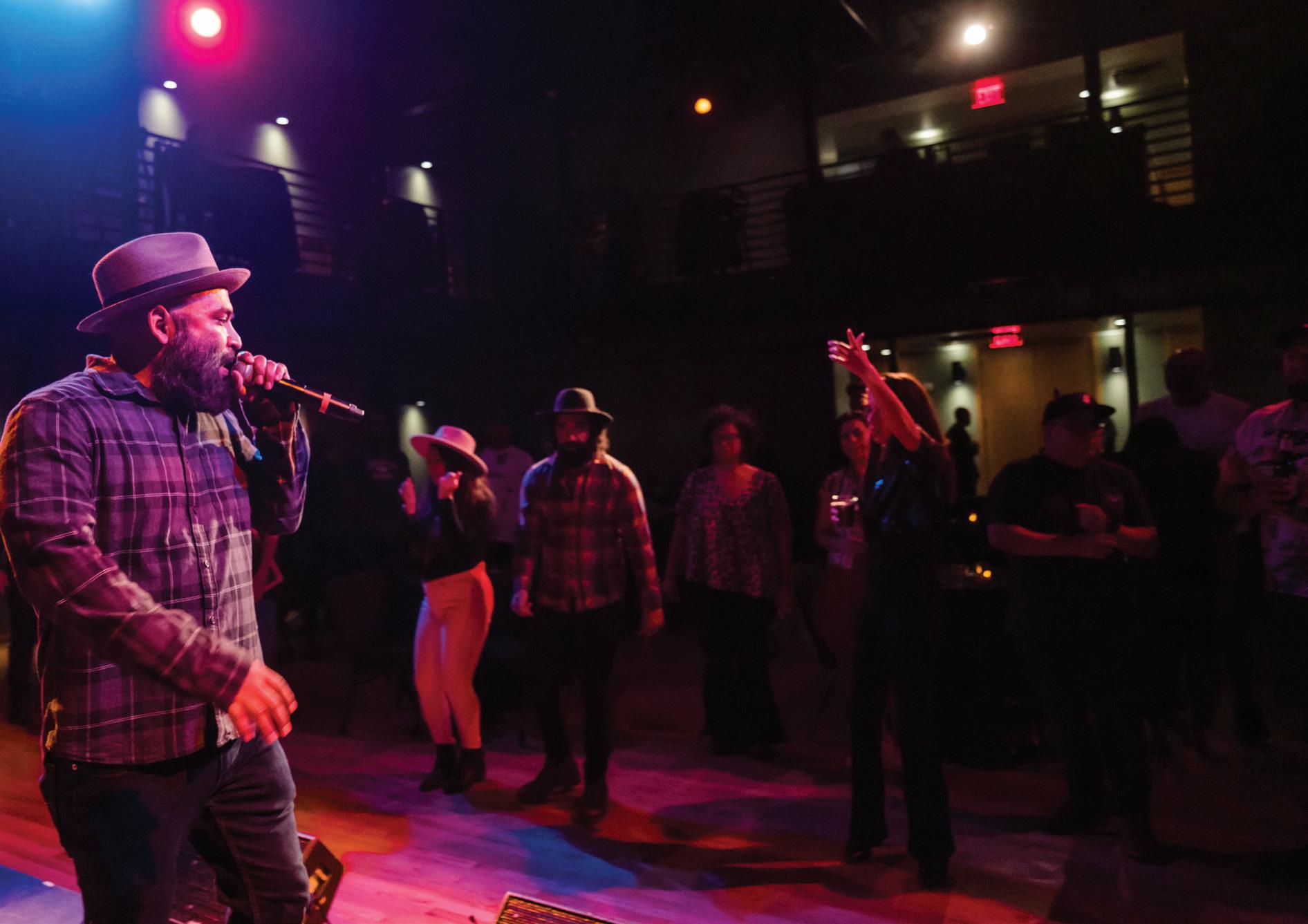
I was working with UTSA faculty Ben Olguín, Norma Cantú, Joycelyn Moody, Sonia Saldívar-Hull and other really amazing mentors like Keta Miranda and Jose Méndez-Negrete who encouraged me. They would look at what I was writing in class and take note of what I was doing out in the community. I felt through conversations with them, I had the confidence to connect the two worlds.
Also, the reading I was doing on the Black arts movement, the Chicano movement and looking at how important poetry and music were to these movements — I felt what I was doing at the time was an extension of that.
Identity, of course, and different injustices. I talk a lot about institutional racism and pointing out some of the issues but also using music in a way to help myself and others push on. I write a lot about pride itself and pride in culture. I think this is something I really tried to do with my latest album “Vivir,” like with the song “Dale Shine” for instance. I talk about the history of the Pachucos and of dressing up in the zoot suits and the low-riders and how those expressions create a sense of pride in yourself and who you are. Also, Black and brown love and solidarity is a big part of what I work on with my music.
I teach classes about culture and history. I feel like music is a big part of the Mexican American and Chicano culture and history for sure when you’re talking about corridos, conjunto and Tejano. If we’re talking about the larger scope of Latinidad, there’s Cumbia and Bachata and other Black diasporic genres. All of these musical genres have histories connected to them. Music has been a way to talk about those histories.
That’s really important for me. Some of the musical choices in terms of genre that I either sample or replay, I try to take from Chicano soul, Tejano, cumbia and trying to preserve that music because it’s such an important part of my identity. Even just making references to our community’s histories that we don’t hear about is another way of preserving our history. I don’t just freestyle — I want to give history lessons through the music.S
References to our community’s histories that we don’t hear about is another way of preserving our history. I don’t just freestyle — I want to give history lessons through the music.
The UTSA soccer team sprints onto the field to celebrate as the final whistle sounds at the 2022 Conference USA Tournament in Charlotte, N.C. The Roadrunners defeated UAB, North Texas and Florida Atlantic in a five-day span to claim the conference championship. The team won 12 games in 2022, the second-most in program history.


hird-day NFL draft picks aren’t supposed to do what Tariq Woolen ’21 and Spencer Burford ’21 did during their rookie campaigns. Players drafted after the third round usually find themselves merely hoping to make the active roster for an NFL franchise. Few of them start for NFL teams. Even fewer undoubtedly thrive in a starting role.
But Woolen and Burford did just that as rookies for rival, playoff-bound franchises on the West Coast. Burford, an offensive lineman and fourth-round draft pick by the San Francisco 49ers, started at right guard from day one of the 2022 season, bringing stability to an offensive line that many football analysts expected to be shaky in the summer.

Woolen, a cornerback and fifth-round draft pick by the Seattle Seahawks, also secured a starting role in the preseason and never looked back. He emerged as a superstar in the Seattle secondary, leading the NFL in interceptions during the regular season before being voted by fans, coaches and players to the Pro Bowl — the ultimate honor for an NFL player’s individual performance.
Highlight interceptions propelled Woolen throughout his rookie season, from the Week 6 pick of Kyler Murray that sealed an important division win over the Arizona Cardinals to the Week 10 play in which Woolen leapt in front of a trick-play pass to legendary quarterback Tom Brady of the Tampa Bay Buccaneers to secure the interception. His favorite, though, was his first “pick-six.” In Week 4 against the Detroit Lions, Woolen quickly identified a pass, jumped the receiver’s route, intercepted the pass of quarterback Jared Goff, dodged a tackler and coasted for his very first NFL touchdown. It’s a trip to the end zone that he’ll cherish forever.

Tariq Woolen and Spencer Burford made a dramatic impact in their first NFL seasons
“In college, I only had one touchdown when I was still a receiver,” Woolen recalls. “So, when I got to the end zone, I was like, ‘Dang, did I really just score a touchdown in the NFL?’ It was a great feeling and a great accomplishment.”
Offensive linemen don’t tend to produce clips for the highlight reel, so Burford focused on something just as important as big plays: consistent performances. He produced multiple games with “clean sheets,” rarely giving up defensive line pressure on San Francisco’s quarterbacks. He even held up well in two matchups with three-time NFL Defensive Player of the Year Aaron Donald of the Los Angeles Rams. The rookie said he wouldn’t allow himself to be intimidated when he lined up across from the future Hall of Famer.

“I knew he was a great player and I’d have to rise to the occasion,” Burford says. “I knew I’d have to improve my technique and tighten down a few things. I have all the respect in the world for Aaron, but I don’t fear anyone. That’s not how I was brought up.”
The Seattle and San Francisco communities have embraced the Roadrunner rookies in a big way. “They’ve shown me nothing but love since I’ve been here,” says Burford, who’s been giving back some love when he can. He and 49ers teammate Leroy Watson ’21, another former UTSA standout, took part in a San Francisco mentorship academy to help teach Bay Area students about the importance of leadership skills and teamwork.

Woolen and Burford were stalwarts on the 2021 UTSA football team that shattered expectations, winning the program’s first Conference USA championship. That team raised the bar for the 2022 UTSA squad, which went undefeated in conference play and brought home a second consecutive league title. After a year in the NFL, both men reflected on the Roadrunners’ current stretch of success.
“That was the original vision when we first got there — me, Frank (Harris), Rashad (Wisdom), Sincere (McCormick) and all the local guys from San Antonio. We wanted to lay a foundation for UTSA. ... When Coach Traylor came in, he instilled a culture that the guys trusted in — that the guys believed in. At the back end, we won a conference championship, and I feel like there are going to be many more years to come where UTSA has successful seasons.”
“Winning the conference championship was always something I wanted to accomplish while I was there and I’m proud of what we did. To see them build off that momentum from 2021 until now, I feel like the UTSA program is going to be a powerhouse. They’ll be a great team for years to come with Coach Traylor in charge. When you play for a great coach that understands the players and makes you feel like a family, it helps a lot.”
Similarly, Woolen and teammate Coby Bryant took a day off from practice to volunteer at Northwest Harvest’s Free Community Market in Seattle. They stocked shelves at the food bank’s grocer and helped promote Washington state’s largest annual food drive. Woolen said he was happy to do something helpful for the folks in the Emerald City who have invested so much in him. As he saw more and more No. 27 jerseys in the stands as he emerged from the tunnel for each home game at Lumen Field, he knew he was making a lasting connection with football fans in the Pacific Northwest.
“I feel like I’m in a movie because — as a kid, and even at UTSA — I always dreamed someone would buy my jersey. It’s the coolest thing ever that people are buying my jersey and wearing it,” a noticeably touched Woolen says. “And it means a lot to me because it goes to show that you’re actually making an impact on and off the field.” S
PHOTOS COURTESY OF THE SEATTLE SEAHAWKS AND SAN FRANCISCO 49ERS PHOTOGRAPHER KYM FORTINO

 by Jordan Allen
by Jordan Allen


At the young age of six, Hafsa Ali and her family packed their bags and moved from Pakistan to Queens, New York, in pursuit of the American dream. Her father supported their family as a cab driver, taking passengers around the city to some of the nation’s tallest buildings, always wondering what took place inside. After driving people across the Big Apple for over a decade, her father decided the family needed more opportunities, and while Ali was in high school, they moved to Texas to make San Antonio their home.
to resources to guide me that I wasn’t able to get from my family.”
As an undergrad, she made it a point to seek out avenues that would help her succeed and joined several on-campus professional organizations, sought out support from mentors, and even took advantage of study abroad opportunities in a business immersion program in Spain. “Through the resources available at UTSA, I was able to land an undergrad internship in risk management. I was the youngest manager in my department, but I was able to be successful through the advice of mentors, even as I made mistakes along the way. I want students to know that they don’t have to figure it out alone. All they have to do is ask and tons of people will be willing to help them,” Ali says.
After graduating in 2018, Ali decided that she wanted to return to UTSA to receive her master’s degree in the Alvarez College of Business.
“I finally got the letter — an admission into the UTSA M.B.A. program. My family and I were so excited, and I immediately went on a mission to apply for as many scholarships as I possibly could,” Ali says. “I told myself that if I couldn’t afford school now, my plan was to continue saving my money until I could. And then I got an email from the UTSA Alumni Association saying that I’d been awarded a scholarship. That was the moment that I decided to sign up for classes and fully start grad school.”
“While I was at the conference, I had some self-doubt, and our program lead, Danielle Gawronski, got coffee with me and inspired me to not settle for anything less than exactly what I dreamed of for my career. And I’m so thankful for that,” Ali says.
As a result of that conference and the mentorship she received along the way, Ali solidified her professional goal of working in product management, leading to an internship opportunity in summer 2022 with a renowned technology company.
She adds, “I worked hard and long hours to ensure that my work was done to perfection. I read books. I did online courses. I asked questions and learned from anyone that I could find to teach me how to find success in this role.”

Her hard work paid off, and at the end of the summer, Ali received a full-time job offer from the company as a product manager in its New York City office, which will begin after she graduates.
In August, when Ali heads to New York City, she will be working in one of those giant New York City buildings her father once wondered about as he drove taxis to support his family.
Growing up, Ali focused her energy on how she could achieve success. As the oldest child in her family, she felt it was important to set a good example for her younger brother and make her family’s sacrifice of leaving their home in Pakistan worthwhile.

With her family’s closest relatives living halfway across the world, she decided to stay close to home after graduating high school and attend UTSA’s Carlos Alvarez College of Business.
“UTSA has a very family feel and 45% of students here are first-generation. So that really lured me in, knowing I would be around people that, like me, are also trying to find their way,” explained Ali. “I knew that I could find access
During her first year of graduate school, Ali joined the National Black MBA Association, a non-profit organization dedicated to the enhancement and development of educational and economic empowerment for African American students and other minority groups. She applied for and was selected to attend their 2022 annual conference in Chicago.
“It’s just one of those very beautiful things that’s happened in my life. Everything has come full circle and my dad was over the moon for me,” Ali says. “The opportunities I got from UTSA are the reason that I’ll be where I want to be in my life and that I’ll be able to change the trajectory of my family’s life — because it’s not just about me. It’s my little brother and other students from low-income and immigrant backgrounds that are just trying to make it. They now get to see me go from an immigrant child with no direction to a college graduate with my dream job.” S
THE OPPORTUNITIES I GOT FROM UTSA ARE THE REASON THAT I’LL BE ABLE TO CHANGE THE TRAJECTORY OF MY FAMILY’S LIFE.
After earning her B.B.A. in finance at UTSA, Yuli Chang ’15 had a pretty good career going for herself as a sales data analyst. But she just couldn’t resist the call to open her own coffee shop. It was something she’d thought about for most of her life, starting in her native Taiwan and peaking during a trip she took with the UTSA Investment Society to visit coffee bean farms in Costa Rica.

“I really got to see what makes the bean tastes the way it tastes,” Chang recalls. “Each farmer could tell you how this process affects the taste — or this weather or this soil.”

That precise devotion resonated with Chang. She’s always been the kind of person who likes to collect data to make an informed decision. She’s always been a fearless go-getter as well. As she eyed a date to leave her comfy corporate gig, she meticulously estimated how much money
she would need to quit her job and chase her dream. With the numbers properly crunched, she made an enormous leap of faith.
“I sold my condo. I sold my house. I sold the car I had,” she says with a bewildered smile that expresses just how daunting that decision was. “I sold everything. I. Sold. Everything.”
The week she put in her notice happened to the be the last week of February 2020. Fourteen days later, the world would essentially shut down as fear of COVID-19 spread. But that didn’t stop Chang from fastidiously gaining knowledge of the coffee business while her plans were temporarily on hold. She attended the San Antonio Barista Academy and even worked at Black Rifle Coffee Company for a spell to learn more about the intricacies of the operation.
By September of that year, she felt confident enough to open Curator Coffee as a pop-up shop
that would make appearances at festivals, churches and established local businesses like Rainbow Gardens. When she found an open retail space in her neighborhood at the Thousand Oaks Shopping Center, she jumped at the chance to buy it — even though it had never been a coffee shop before. Chang, her now-husband and their friends put in a tremendous DIY remodeling effort to launch the business in March 2021 and make her vision a reality.
That vision was twofold: to curate freshly-roasted coffee from a variety of local roasters, and to house ceramics and paintings by local artists who may not otherwise benefit from the retail spotlight. In addition to being a barista, Chang has long found solace in creating ceramic art during her off hours. She wanted to give other part-time artists the opportunity to showcase their creativity and sell their wares.

“Honestly,” she admits, “I thought it would be cool if I could serve coffee in the mug that I made.”

Much like her infectious energy, Chang spreads that creative spirit to her customers through weekly “Painting with Coffee” classes and monthly ceramic workshops. Curator Coffee’s uniquely-crafted lattes, pour-overs and teas will tantalize your taste buds, but the shop itself aims to tantalize your imagination.
Lavender Latte
Rose Latte
Honey Yuzu Tea
CURATOR COFFEE 2923 THOUSAND OAKS DR. #4, SAN ANTONIODrinking chai tea wasn’t just a lifelong pastime for Nirav Amarnath ’20. It was a meaningful obsession.
“Growing up, I drank chai every morning. It was almost a religious thing for me to do,” he says pensively before giggling through his next sentence: “I guess that’s why I was so hyper every day.”
Chai is a go-to get-me-up in Indian culture and it gave Amarnath daily fuel as his family moved from his birthplace of Bakersfield, California, to Corpus Christi to the small North Texas town of Vernon. But when he came to San Antonio to attend UTSA, he faced a new conundrum: the chai he was making was nowhere near as good as his mother’s or his grandmother’s. “It was miserable,” he admits.
So, he began pestering them with phone calls and he would studiously watch as they brewed
chai whenever he went back to Vernon to visit. A chemistry student by trade, he was scrupulous in his measurements. Eventually, he started getting pretty good at making chai and even began perfecting his own recipe. It was so well-received that his room became the morning pit stop for many of his friends hoping to get a chai fix before they bolted to class.
As they embraced his culture, he embraced Texas coffee culture and the undeniable power of the latte. That’s when he began contemplating opening his own hybrid chai/coffee house. He’d noticed that Houston and Austin had chai houses, but there was a noticeable gap in San Antonio.
“I thought it would be a good market and I could build a chai culture here,” Amarnath says.
Upon graduation, he set out to build his ideal chai/coffee haven. He attended the Texas Coffee


School in Arlington to brush up on the coffee business and also went on a months-long trip to India and Singapore to develop authentic offerings and learn how to make drinks like Masala Chai on a large scale. He then found a prime location on Broadway, just a short walk from the Pearl.
Amarnath officially opened Amaretti Coffee in September of 2021. While chai tea and lattes are the obvious stars of the show, Amaretti Coffee also offers an assortment of fresh-made vegan baked goods like pop-tarts, kolaches, donuts, cinnamon rolls and muffins from Cake Thieves Bakery. Amarnath is also proud to note that the Wi-Fi is strong and there’s a charging port near every seating area.
“I wanted to do something that felt like a modern coffee shop — that was photogenic and relaxing — but just had my twist of Indian fusion to it,” he says.
What customers seem to appreciate most is that Amarnath wants them to be 100% pleased with their purchase.
“If you’ve never had chai before, I’m always happy to give you a sample,” he says. “You can always try it before you buy it. And if you don’t like it, that’s cool too. It’s not for everyone.”


Spoiler alert: The customer pretty much always likes it. S
Masala


Turmeric


 AMARETTI COFFEE 1800 BROADWAY #1131, SAN ANTONIO
Dirty Chai Latte
Chai
Chai
AMARETTI COFFEE 1800 BROADWAY #1131, SAN ANTONIO
Dirty Chai Latte
Chai
Chai
Classical musician and UTSA professor uplifts others with her instrument
 BY VALERIE BUSTAMANTE JOHNSON
BY VALERIE BUSTAMANTE JOHNSON
For Nicole Cherry, assistant professor of violin and string area coordinator at the UTSA School of Music, the violin is more than an instrument that she learned to play when she was 12 years old. The instrument has taken her across the globe to perform and collaborate with some of the greatest musicians in the world. But most importantly, it has enabled her to break down historical barriers and engage diverse communities in the joys of the music.
How did you get started in music? What sparked your interest?
NC My father was an amateur pianist and after dinner, as a young child, I would often find myself sitting at my father’s feet as he played piano. He would play anything from Thelonious Monk to Franz Schubert as well as some of his own improvisations. It was natural for me to play music, and so I started learning piano at age six and then violin at age 11 in public school. Soon after that, my older brother, who is a bassist, would take me to improvisation sessions, and I think this was the beginning of my curiosity surrounding the possibilities of music.
You have an extensive professional career that allows you to travel the world and meet so many people. Did you ever think you’d have that opportunity?
NC In just the last three years, I have performed on four different continents, and when I think of that, I am grateful but in disbelief. What I have learned is that when someone believes in you, it allows you to believe in yourself.
Growing up, I was a member of the DC Youth Orchestra Program, and during my time there, we toured the world. We performed before dignitaries, premiered symphonies, met some of the greatest artists of all time. We would perform for the White House on a Friday, then have our regular rehearsal on Saturday, oblivious to the impact we were having on our own lives as well as others.
Little did I know then that I was sitting within a student orchestra made up of many of today’s award-winning international performers, orchestral players and arts administrators. That experience gave me a place to feel represented, to be part of a nurturing community, where I was not just a violin player, but part of a group that was needed to make it whole.
What did representation look like in the classical music community when you were growing up?
NC When my classmates and I at the DC Youth Orchestra worked with the American composer Talib Rasul Hakim, we were able to make music in real-time with this living composer. We could experience the music literally evolving and transforming just because we were there together, which was life-changing.
At age 16, I gained some courage, mostly out of my own curiosity, and took it upon myself to connect with as many artists as I could. I reached out to several composers — everyone from the great Quincy Jones to Jonathan Wolff, the composer of the “Seinfeld” TV show music.
One significant meeting for me was with the American composer Noel DaCosta. He invited me over for lunch to talk music and mentioned that his role model for composition was Harlem Renaissance poet Countee Cullen. From this, I learned to stay open to anything that might inspire me.
How are you applying those realizations here at UTSA?
NC I think that’s what is beautiful about UTSA. Learning about musicians and composers from many different races, ethnicities and cultures is an intentional part of the educational curriculum.
Great music programs can be built by understanding the context of the people and places that surround us. This past year at UTSA, I began a string band in which we explore music from all over the world from a historical, cultural and performative point of view. Recently, I introduced a new piece, Mi Negra by Jesús Florido, to the group. Many of the students, though they had heard these sounds before, could not easily translate it from the score. After much conversation with and without instruments and many student-led rehearsals, they were able to perform it beautifully. This is what I call a creolized music education — one that evolves from different components of many languages across the diaspora.
Sombrilla Magazine sat down with Dr. Cherry to learn more about her journey.
Tell me about your scholarly work and how it relates to what you’re doing outside the university as a performer.
NC My scholarly work is built around a project I started in 2016, FORGEwithGEORGE. The project is named after 19th century African-European violin virtuoso George Augustus Polgreen Bridgetower. My goal is to commission an entirely new body of repertory for violin each year until the 200th Anniversary of the Slavery Abolition Act in England, where Bridgetower lived.
Currently, I have commissioned over two dozen compositions and premiered many of them with collaborators worldwide. The project is a combination of performances, lectures and recitals where I’m hoping to restore the legacy of great artists of color that have been dismissed from our history books.
Tell me about your work with the Marian Anderson String Quartet and what led you to join the group.
NC I am proud that I was a fan of the group for more than a decade before I became a member, and I have now been a member for 22 years! The Marian Anderson String Quartet encompasses all that I believe in as an artist — building community and sharing art inclusively to all communities. The quartet has performed at presidential inaugurations, the Library of Congress and more. They made history in 1991 when they won the International Cleveland Quartet Competition — the first African American ensemble to win a classical music competition.
And yet, no stage is too small — and no stage is small. One day we could be playing in the Lincoln Center in New York and the next day playing at the YMCA or a prison. We come to them and share our experience of loving classical music. We’ll play Mozart and other classical composers alongside many composers who are people of color.
I am motivated by that mission and what we do to honor the legacy of our namesake, Marian Anderson. S
